Brief History of The Midland Railway of Canada
formerly: 1) The Port Hope and Peterborough Railway(1846-1854) 2) The Port Hope, Lindsay, and Beaverton Railway(1854-1869)
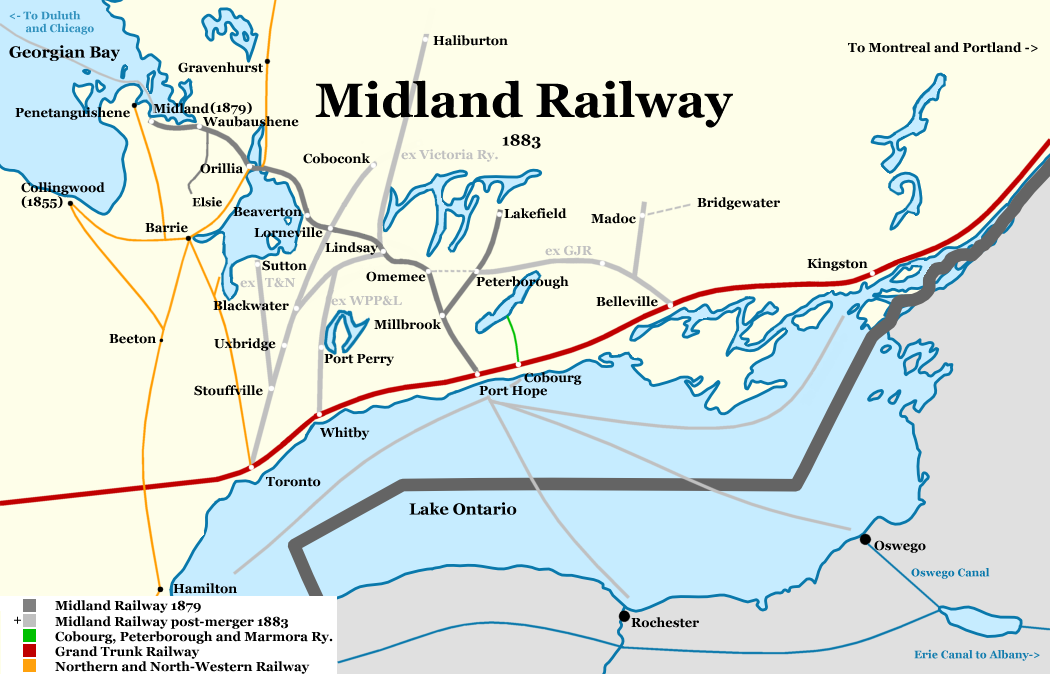
Introduction
This story begins on the shores of Lake Ontario in the small Town of Port Hope. The Port Hope and Peterborough Railway was incorporated in 1846 to assist in the transportation of wood products to the various international and domestic markets, and thus provided employment and income for the outlet harbour town of Port Hope, Ontario, as well as procure a profit for investors. Although this initial charter would not be acted upon due to a lack of outside investment, a succeeding revised charter that included a change in the name of the company to "The Port Hope, Lindsay and Beaverton Railway", would be successfully constructed to the town of Lindsay, Ontario, by the end of 1856. If all had gone to the letter of the prospectus, the PHL&B would have been constructed on budget and properly maintained; the lumber and timber trade, from which the company's main source of revenue was to be derived, would be brisk and steady year after year; the employees would be paid reasonable wages and not have to strike; the investors would collect their dividends and not have to foreclose; and the line would expand it's reaches by utilizing a surplus in profits, additional outside investment, and grants from the municipalities along the projected route. Unfortunately, it never seemed to work out that way for those early-Ontario, or Canada West as it was known back in the day, railways.
The forces at work against such an outcome were numerous. The directors and associates of the railways would often have a hand in undermining the finances from the very beginning. Land speculation along the projected right-of-way, or even directing the course of the right-of-way over certain lands, with the intent of selling at an inflated and uncontested price, was a common course of action. The Grand Trunk had almost re-routed their line to the north of Port Hope due to the asking price for lands along the planned right-of-way, held by James Smith, president of the Port Hope, Lindsay and Beaverton Railway, and members of his family. Directors and associates could also charge premium prices, and grant themselves bonuses, for services rendered. After all, without their law and business expertise, not to mention government connections, it is doubtful the line would have received a charter in the first place. Actions done out of spite, such as re-routing away from, or refusing to build stations in, municipalities that did not contribute financially was potentially injurous to not only the municipalities' prospects, but also the railway company. This was certainly the case when the Port Hope and Peterborough decided to change the terminus of the railway from Peterborough to Lindsay. Furthermore, the contractors hired by the company to construct the line would inevitably underestimate the costs of construction and, as specified in the contract, make their claims for extra work that had been carried out prior to the iron rails being laid. All of these lessons learned in grade school regarding the management and construction of early-Canadian railways were, to some degree or another, true of the Port Hope road as well.
Naturally, this sort of hoggish attitude by many concerned, coupled with the an inability to meet future financial obligations, helped fuel a general mistrust in the railways of the day and therefore outside investment was hard to come by.
Sources of funding came through government or public investment in company stocks and bonds, and later municipal grants or bonuses. Both stocks and bonds come in various forms. For instance, the stock may pay a dividend, or come with certain voting privileges at annual company elections, or hold preference over common stock, or a combination thereof. The bonds generally have preference over the stocks, and are linked to a mortgage on the railway company's estate for security. The company pays annual interest on the bonds and would issue second-preference bonds, succeeding a first-issue, if necessary and pre-authorized. Authority to issue bonds is granted in an Act of the Provincial Parliament at the request of the company and other interested parties such as the municipalities.
If the company failed to pay a creditor, a writ of execution could be obtained through the Court of Chancery and acted upon by a local Sheriff, who would seize company property and auction it off. If the company becomes bankrupt, or "financially embarrassed" as they would say, the bondholders would usually be authorized to take control of the railway, as it was unlikely under Canadian law that the company would be liquidated given the investments made, in the railway, by the municipalities. A reconstruction of the company to free it of all or a portion of it's floating debt was the usual next step, and is also authorized by the government. In general the unsecured creditors and the common stockholders are the losers in such situations, followed by preferred stockholders and second mortgage bondholders who may be given common stock. The winners are the secured investors with first preference on the estate who have government approval to rid the company of a portion of it's debt; those who would capitalize by investing in the embarrassed company; and all who rely on the railway, directly or indirectly, for income.
The Port Hope company was unable to sell it's first-preference bonds secured by mortgage and the contractor of the road, Samuel Zimmerman, was forced to take the vast majority as payment. It was hoped that the Grand Trunk Railway would take up the remainder to provide an influx of working capital. The paid up stock however had reached a total of £205,000. Most of the money came courtesy of the Municipal Loan Fund which allowed municipalities to borrow on the province's credit. Port Hope had invested a staggering amount of money into a railway that initially was unable to support itself, and twenty years later the railway was still asking the town for money. By 1883, the total paid up stocks and bonds issued by the Midland Railway of Canada would rise to approximately £1,500,000.
The name "Port Hope and Peterborough" would again be revived when a branchline of the Port Hope, Linsay, and Beaverton Railway was built from the town of Millbrook, on the mainline, to the town of Peterborough. The contractor and proprietor of the branchline, John Fowler, would lease running rights over the PHL&B mainline between Port Hope and Millbrook and call the whole concern "The Port Hope and Peterborough Railway". The competing railway of the Port Hope and Peterborough was initially the Cobourg and Peterborough Railway, which was already established in Peterborough prior to the branchline being built from Millbrook.
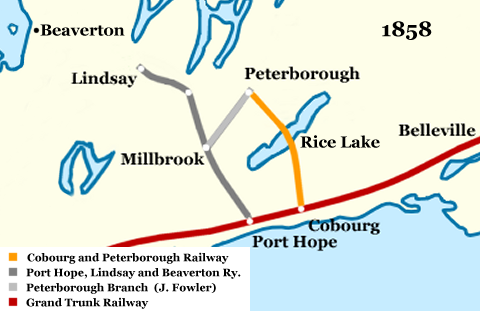
- 1846 - Incorporation of The Port Hope and Peterborough Railway
- 1854 - Port Hope and Peterborough Railway changes name to "The Port Hope, Lindsay and Beaverton Railway"(PHL&B Ry.)
- 1854 - Cobourg and Peterborough Railway constructed.
- 1858 - Branchline of PHL&B constructed to Peterborough. Propreitors lease portion of PHL&B between Millbrook and Port Hope and name the combined route "The Port Hope and Peterborough Railway".
The names of the railways would remain as such until the Port Hope, Lindsay and Beaverton absorbed the Peterborough branch, thus eliminating the Port Hope and Peterborough Railway. The Cobourg and Peterborough was only ever in direct competition with the Peterborough branch for a few months before it was leased to the proprietors of the latter in 1859. It was later sold to and American Company that owned the Marmora Iron Works, and would be merged into the "Cobourg, Peterborough and Marmora Railway and Mining Co."
The Port Hope, Lindsay and Beaverton Railway would change it's name again in 1869, and become "The Midland Railway of Canada".
In 1882, the Midland would merge with five other railways in the Midland region under the same "Midland Railway of Canada" name. The post-merger Midland line from Port Hope to Midland would be referred to by the new management as the "Midland section" of the consolidated railways and later, under Grand Trunk influence, the Midland Division.
The other railways involved in the merger were the Toronto and Nipissing(T&N); The Whitby, Port Perry and Lindsay(WPP&L); The Grand Junction Railway(GJR); Victoria Railway Company; and the Toronto and Ottawa Railway. Each of these roads, including the Cobourg and Peterborough, have there own very interesting histories that have already been covered by others, and therefore are not covered in any great detail here. I will provide a list of books available at the libraries and/or on the internet for those wishing to investigate further.
The greater achievement, regardless of the success and failures of these railway companies, would be in the contribution to the overall growth of the Canadian economy by all who prospered from having a transportation network to facilitate domestic and international trade, as well as the development of the back country.

David Smart (1795-1867) President of the Port Hope and Peterborough Railway (1846-1853)
David Smart was an early magistrate, postmaster, and businessman in the Town of Port Hope, which was incorporated in 1834. He was proprietor of both a store on Ward St. and the Durham Distillery on Cavan St. where some of the famous Port Hope whiskies were produced. His tenure as postmaster spanned 50 plus years. He and many other prominent citizens of the town applied for and received the first charter for the Port Hope and Peterborough Railway Company in 1846. The first group of directors/stockholders decided not to proceed with construction because of a lack of outside investment in the project. A survey was however conducted which avoided the Ganaraska valley by first heading west to the village of Port Britain, however it was never adopted by the successor group of directors who chose to run the road due north. Although disappointed by this, Smart remained a loyal supporter of the railway until his death.
His son, David Smart Jr., a barrister in the town of Port Hope, would however vote against a future, and perhaps deciding, as far as the future of the town, harbour and railway were concerned, by-law to assist the railway extension to Midland under the Hugel regime.
Among other notable stockholders under the initial charter were John David Smith, son of United Empire Loyalist and original Port Hope settler Elias Smith, Francis Beamish, and Nesbitt Kirchhoffer.
Initial Survey
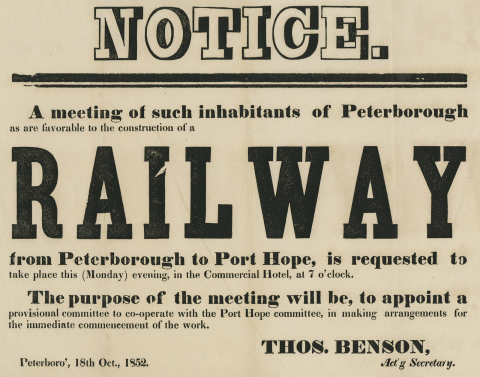
Toronto Reference Library - Baldwin Collection
"Some unnecessary sneers indulged in by the people of Peterborough caused the projectors of the road to transfer their line to Lindsay" said Francis Beamish, a director of the company at the time and future Mayor of Port Hope. With the Cobourg railway already servicing the town, the citizens of Peterborough declined to make a financial commitment to the initial Port Hope railway scheme, resulting in the re-routing of the line to Lindsay, Ontario, and the subsequent change in name of the company to "The Port Hope, Lindsay and Beaverton Railway".
The intitial survey of the road was interesting in that it would head west of Port Hope for a few miles, then north for a distance, then sweep east through Garden Hill and still further east into a sweeping curve north into the village of Bewdley at the head of Rice Lake, and then northeast on the final leg of the journey to the town of Peterborough. A few miles to the north of Bewdley is where a branchline would be constructed northwest to the town of Millbrook. This route, no doubt, would have been ideal for the fledgling company to build given the access to Rice Lake and a much lower startup cost than the longer, less cost effective, new route to Lindsay. Years later the idea to build a branch to Rice Lake would be floated in a local newspaper, citing the time wasted when traveling from Port Hope to Rice Lake via Peterborough as detrimental to the tourism trade. A Cobourg newspaper would also suggest a similar branchline but with a connection at some point with the Cobourg and Peterborough Railway, inferring that once the line had reached Georgian Bay the abundance of new traffic would need an additional outlet, and the surplus could be diverted through their harbour. Of course, with the passionate rivalry that had always existed between the two towns, this idea went over Port Hope like a lead balloon.
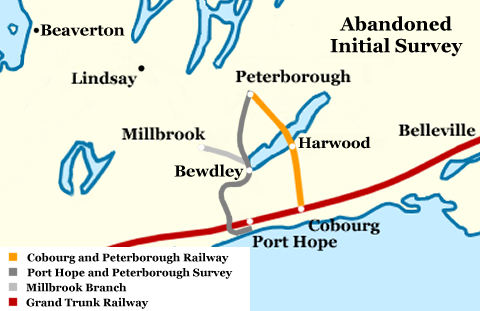
The said rivalry between the two towns was quite humorous at times with the newspapers trading insults with each other.
"You Port Hopers call our town "Sleepy Hollow", but we are not so sleepy as you make us out to be. We have a cow by-law that keeps our streets and sidewalks clear of cows; and at any rate, that is more than you can say. We have base ball matches here, too, on Sunday..."
Cobourg had built the first railway in the region, the Cobourg and Peterborough, a few years in advance of the Grand Trunk and Port Hope railways. However, the Port Hopers would have the advantage of not having to build across a lake on route to the back country. The argument for not building the railway around the lake was that it would likely be miles longer in length than a railway built north from Port Hope, and therefore unable to compete for business in Peterborough and points beyond. John Fowler had however threatened, while his branch was under construction to Peterborough, to connect with the Cobourg line instead of the Port Hope road if his demands were not met. Under the circumstances, the Port Hope and Lindsay road would not have been able to counter the threat, for lack of funds to build to Peterborough was what brought Mr. Fowler onto the scene in the first place.
James Smith (1811-1874) President of the Port Hope, Lindsay, and Beaverton Railway (1853-1859)
James Smith, son of the aforementioned John David Smith, was elected president of the Port Hope and Peterborough Railway in early-1853. With guidance and financial help from contractor Samuel Zimmerman, Smith was able to obtain the necessary means to construct the line from Port Hope through to Lindsay. One of the most prominent members of Port Hope society, Mr. Smith had been president of the police board for many years; the mayor in 1851; a member of the provincial parliament from 1848-1854; and a judge for the County of Victoria.
Despite the change in presidency of the company, many of the directors, with the addition of Thomas Ridout and William Fraser, remained the same. The secretary and treasurer was the beloved and admired Thomas Benson, who passed away, along with railway's contractor, Samuel Zimmerman, in the DeJardins Canal railway bridge disaster on Mar 12, 1857. The resident civil engineer of the company was Thomas Clarke who, along with the company's draftsman and civil engineer Edward Haycock, would later construct the east and west blocks of the parliament buildings in Ottawa. Mr. Clarke would also partner with George Tate, former engineer to the contractors on the Grand Trunk Railway through Port Hope, in operating the mainline of the railway.
Unfortunately, the railway failed to meet it's prospectus, as did most, and Mr. Smith and company decided that it would be most prudent to hand over the road to the bondholders, resulting in many years of stagnation as far as expansion was concerned. Under the new management, however, the pressing financial executions were paid. (note that in the John Fowler's speech below, many of the executions brought against the road originated from the company's own officers and president, Mr. James Smith)
Building to Lindsay and Peterborough
The initial stretch of track up the Ganaraska Valley and then on to Millbrook was completed by the famous railway contractor Samuel Zimmerman ("Mr. Z") in November, 1856. It was at this time that the company intended to make an application to the Provincial Parliament to extend the railway to Georgian Bay and create a harbour there - a feat already accomplished by the Northern Railway, between Toronto and Collingwood, in 1855. A few months previous to the arrival of the line in Lindsay, a promoter had this to say:

Lindsay, Ontario - Picturesque Canada
"The day in which the nuptials of Port Hope and Lindsay are solemnized will be an important one in the history of this town--We will at once experience the benefits of this Union. But it will be cast into the shade by the superior brightness of the era which will be inaugurated, when the waves of the Georgian Bay are linked by nerves of iron to the waters of our magnificent harbor."
Once the railway and harbour were operational, the main source of revenue for the companies, squared timber and sawn lumber, could make its way to markets in the United States and overseas. Much of the lumber would travel across Lake Ontario via schooners to the port of Oswego, New York, and then through the canals to the great lumber distribution center of Albany, New York. For shipments overseas and markets in Quebec, the product could be rafted down the St. Lawrence during the navigation season, or transferred to the Grand Trunk line for export at the winter port of Portland, Maine.
The line was complete to Lindsay in Dec, 1857, and in 1858 a branch was constructed to Peterborough by the railway contractor John Fowler. He and partner George Tate of Toronto, who operated the mainline to Lindsay as well, had a lease to run the Peterborough trains on the mainline between Millbrook and Port Hope. With the only gradient of consequence (ascending against the traffic) being on the mainline south of Millbrook, and then all downhill to the harbour, the branchline was a more cost effective road to operate than the rival Cobourg and Peterborough Railway which was burdened with higher operating costs due to long gradients and constant repairs and improvements to the Rice Lake bridge/causeway. Given the conditions of the lease, the new branchline, or Port Hope and Peterborough Railway as it was called, was in relatively good financial condition.
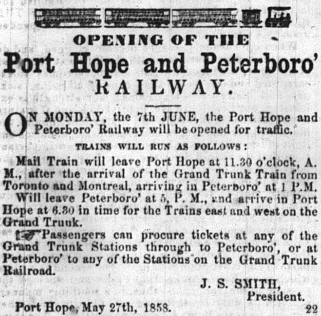
Cobourg Star
"On Tuesday, Mr. Keefer, Government Inspector of Railways, passed over the Peterborough and Port Hope Road. A special train under the care of Superintendent Williams left town at an early hour in the morning, having on board Mr. Keefer, the President of the Railway Company, Mr. Ridout the Engineer and several Directors. The line from Port Hope to Peterborough underwent a rigid scrutiny at the hands of the Inspector. He examined the bridges, culverts, embankments and cuttings with great care, and if there is a defective spot on the route it certainly has been seen by him. We understand that he expressed himself as highly pleased with the Road, and at once gave permission to run passenger trains to Peterboro'."
"The Millbrook and Peterborough section is a beautiful piece of road. From the limits of Peterboro' to the boundary line, a distance of seven miles, the track is without the slightest curve, and as nearly a dead level as any of the railways that cross the Prairies of the West. There is only one small bridge to cross; and no embankments exceeding FOUR FEET in depth, nor cuttings over SIX FEET, are to meet with."
"There is an ascending grade of about eleven feet to the mile from Peterborough to Millbrook, which shows the latter place at about 130 feet above the former, and rather more than 150 feet above Rice Lake. This of course reduces the grade from Peterboro' to the summit, and gives our Road an immeasurable superiority over it's defunct rival - the Cobourg line."
"Mr. John Fowler has done himself credit as a railway man by the manner in which he has finished the Branch. The cuttings are nicely sloped, and the embankments are handsomely terraced, thus securing immunity from land slides, and perfect drainage. The ties are all of the same length, and being laid with the ends in a straight line with each other, present a fine appearance."
"The Port Hope and Peterboro' Road may be considered a first class Railway; the grades are easy; the bridges few and of the best description; the passenger car are splendidly fitted up; and the general management of the line admirable. Port Hope and Peterboro' have every reason to be gratified at the manner in which their money has been expended."
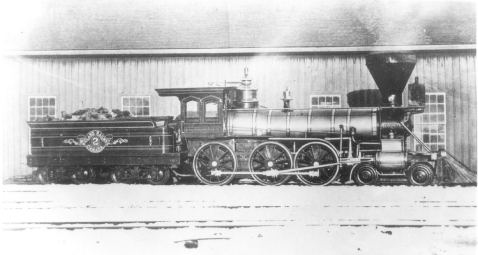
Port Hope, Lindsay, and Beaverton engine "Lindsay" w/54-inch drivers ca. 1869
Unfortunately, with an economic downturn almost immediately after completion, and higher operating expenses, the same could not be said for the mainline to Lindsay. As with many roads, the start up cost were too high and help from the municipalities too low - Cavan and Emily contributing nothing. Furthermore, as built, the line had a heavy grade against traffic that I calculated to be on average 2.7% over two miles. Two other grades calculated at just under 1% not including the above mentioned grade out of Millbrook at .75%. (Given the one stretch of steep gradient, it's not much wonder why the contractor purchased the unusually large [for the late-1850s] engines with smaller driving wheels for the road.) As a consequence of all of the above, the company failed to generate enough revenue to pay the interest on the bonds, and with pressing executions in the hands of the Sheriff, the road was shut down for a time and eventually surrendered to the bondholders in early-1859.
That this board being unable to raise money to discharge the interest in arrears upon the bonds, to put the road in working order, and to discharge the existing liabilities of the company, will offer no opposition to the trustees of the Bondholders taking possession of the railway from Port Hope to Lindsay, according to the terms of the mortgage" - March 18, 1859
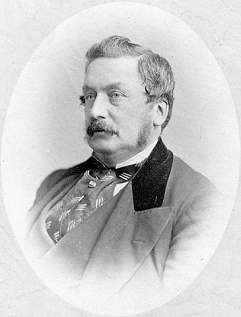
Frederick Cumberland - Library and Archives Canada
The appointed trustee of the bondholders and the Bank of Upper Canada was none other than the managing director of the Northern Railway, Frederick Cumberland. Being that the branchline to Peterborough was owned by that town and John Fowler, a battle ensued to wrestle it from him to further the cause of the company and it's creditors. Mr. Fowler's narrative on his struggle with the directors and then the bondholders are documented in his speech "The History of a Railroad Difficulty", performed free of charge at the Town Hall in Port Hope:
The History of a Railway Difficulty by John Fowler
As mentioned at the end of Fowlers memoir, the solicitors for the towns of Port Hope and Peterbough were successful in preventing the sale of the mainlines(PH&BRy) rolling stock, and the road was reopened once the executions were paid by the bondholders. Note that D'Arcy Boulton, future president of the Midland Railway, was the legal representative for the town of Peterborough and private stockholders.
Said, tongue in cheek, about Fowler after the speech:
John Fowler, Esquire, is a man of great versatility of talent--on a whole a gentleman of most prodigious powers. He can build 12 miles of Railway in a month. He can make and unmake Railway Boards; and in fact is now the greatest personage in the Province, being absolutely the Consort of "the Queen".
Recently, John Fowler has turned his attention to literary pursuits. He has entered the field as a public lecturer. Accustomed to bullying "navvies" he has picked up a classical style of speech, which he carries with him to the rostrum. He frequently rounds a polished period with an oath that makes the hair of piously inclined people stand on end, and draws out "three times three" from the sporting characters in the "pit". And as for blackguardism, why, Mrs. Moriarty with whom Dan O'Connell had such a remarkable passage at arms, could not in her palmiest days "hold a candle to him."
The reference to a)the "twelve miles of railway" was the branchline between Millbrook and Peterborough; b)"the Queen" was Mr. Fowler's Kingston built locomotive named "The Queen"; c)"three times three" are a sequence of hip hip hoorays; and d)Mrs. Moriarty the pugnacious and vulgar old lady in Dublin, Ireland. Biddy Moriarty vs. Dan O'Connell
And as such the railway was operated (under the bondholders and Frederick Cumberland) for the coming years.
Cobourg and Peterborough Railway
John Fowler was contracted to continue construction on the road after it was partially constructed by Samuel Zimmerman in 1853-54. After gaining the initiative over Port Hope to control harbour exports from the north, the road immediately became burdened by the three mile long bridge built across Rice Lake that was poorly engineered and gave way almost every winter against the forces of the ice. Eventually, under the management of D"Arcy Boulton, a plan to cut the ice had provided temporary relief, however, once relieved of his lease the problem had reoccurred the following spring. In 1858 government aid was granted for the purpose of building a causeway in place of the bridgework. A stipulation of the new lease required the operator to relinquish all profits toward construction of the causeway. By the end of 1859, however, only about a half-mile on the shallow end of the lake was completely filled in, the grant money was expended, and the Port Hope and Peterborough railway was back in operation. Revenues fell further, and with the executions pilling up the rolling stock would have to be seized by the Sheriff. Of all the great accomplishments of Samuel Zimmerman, this bridge was certainly not one of them.
It was later calculated that with an abundance of course gravel and sand available in the make up of the hills on either side of the lake, that a causeway could have been made at half the cost of the bridge.
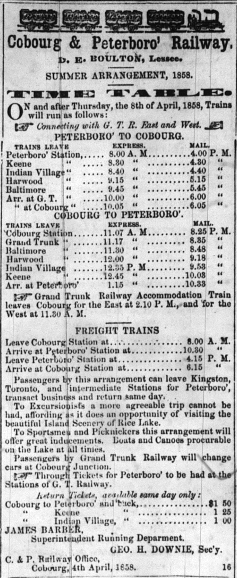
Cobourg Star May 5th, 1858
Mr. Fowler claimed that the Peterborough branch of the Lindsay road would never have been built if he had been given the lease of the Cobourg road in place of previous and current lessees D'Arcy Boulton and John Dumble, respectively. All would have been right with the bridge! Now "the Cobourg road's days are numbered..." said Fowler. Fowler was also bitter about not getting the contract to build the causeway after placing the cheaper bid.
Soon after, late in 1859, the lease was taken from Dumble and given, by the bondholders, to none-other than John Fowler, and his new partner on the Port Hope & Peterborough branch, Henry Covert of Cobourg. The bridge functioned during the season of 1860 but closed down in the fall. The new lessees then had all of the reusable iron removed from the bridge and sections floated off down the lake in the spring of 1861.
A trip over the bridge in that final year was described as such:
"And now we behold and admire one of the vast projects of human ingenuity. Crossing this verdant sheet of Western water (its name indicates that it is covered in rice) is a bridge, in length exceeding our Victoria Bridge by at least a mile. The bridge is firm and strong, and over we go, pretty comfortable for a little way, But--steady--now here's a burnt place; it doesn't creak much, though--over the drawbridge. Slow now--slowly! It creaks a little here, and we are near enough the surface of the water,--but not very near the bottom of it. These piles were at first driven straight down into the mud, but they are now pointing at the pole star and all the stars about it."
"No danger, ladies and gentlemen; if she does go down, she'll go easy, and there are plenty of logs to creep out on! Well, now we are over, and stop for a minute at the Indian Village, and another at Keene Station, and then off to Peterboro'."
John Fowler and Henry Covert continued to operated the road with steamer and sleigh filling in the gap across the lake. Dispite the difficulty, a good portion of the lumber trade was carried out of Peterborough by the Cobourg road. In 1862, an act was passed to transfer control of the road to the original stockholders - presumably D'Arcy Boulton and Henry Covert. A few years later the road was sold for a diminutive profit to a group of Pittsburgh steel men who had just purchased the Marmora Iron Company.
William Cluxton (1819-1901) President of the Port Hope, Lindsay, and Beaverton Railway (1860-1863)
Road under the control of the Bondholders
Under the general management of Frederick Cumberland, general manager of the Northern Railway, acting as trustee for the bondholders, William Cluxton of Peterborough was appointed president. Cluxton was a very successful businessman who first worked for a Port Hope based general goods company before operating his own Peterborough based dry goods/grain business that utilized the railway from all points down to the harbour at Port Hope. He would later be elected vice-president of the road after the bonds was purchased by Henry Covert and company.
James Fortune (1813-1864) President of the Port Hope, Lindsay, and Beaverton Railway (1864)
James Fortune had held the presidency briefly prior to his early death in 1864. Mr. Fortune was a former director and original stockholder of the Cobourg and Peterborough Railway before becoming Sheriff of the United Counties of Durham and Northumberland, based in Cobourg. He also owned a sawmill at Gore's Landing on Rice Lake. Possibly not wanting to have to act on financial executions against his own estate, Sheriff Fortune had placed his Cobourg property in his wife's name. Today, the old house is a bed and breakfast and is featured in the book "Haunted Ontario 4"
Henry Covert (1814-1893) President of the Port Hope, Lindsay, and Beaverton Railway (1864 - 1971)
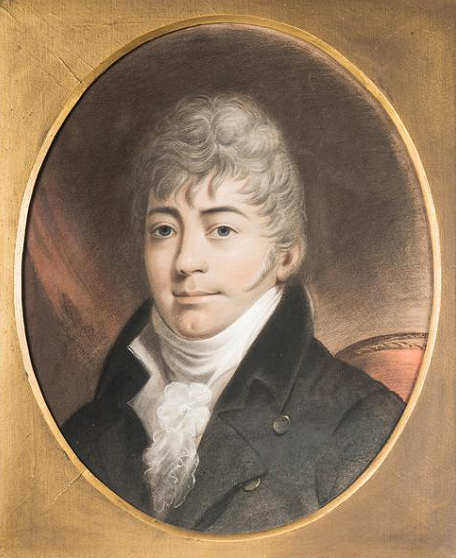
Henry Covert
Henry Covert moved to Canada as a boy with his well-to-do family in 1820 and settled on an estate property just east of Cobourg. He would become clerk of Newcastle District in 1836 at the age of 23, and would be commissioned to first lieutenant in the Northumberland militia in 1838. In 1843, as Cobourg was entering into a boom period, Henry would inherit his father's estate, which included Harbourfront properties in the town as well as land in Hamilton and Otonabee townships on either side of Rice Lake. At this time Mr. Covert was also involved as a leading member of the Newcastle District Jockey Club with his future partner, in the railway business occupation, D'Arcy Boulton. Obviously a horse and sport enthusiast, Covert was a steward of a "Grand Provincial Steeple Chase" held in Cobourg in the fall of 1848, with his own horse "Royal", the favourite, entered in the competition along with "Lady D'Arcy", presumably Boulton's horse. Mr. Covert seemingly enjoyed boating as much as the railway business, and as operator of the Cobourg and Peterborough he and John Fowler would contributed a silver cup to the winner of the 1860 Cobourg regatta. Later in life he would purchase a schooner named the "Forest Queen", which would unfortunately become a total loss when run aground in a snow storm near Belleville.
When the Cobourg and Peterborough Railway was incorporated in 1852, Henry Covert was, along with and under the leadership of D'Arcy Boulton, among the initial investors in the company. When Mr. Covert was President of the railway, he advanced his own money and put up his own bonds as security on loans to keep the road functioning and advance the construction of the causeway across Rice Lake. In Febuary 1957, Mr. Boulton had leased the line for £9,000 per annum, but was unfortunately unable to advance the first installment of the 1958 rent after the initial year of his lease had ended. Soon after, Sidney Smith, a leader among the stockholders, and local M.P. for Northumberland West, had the railway handed over to the bondholders. Although Mr. Covert, as a bondholder himself, and contractor John Fowler, had wanted to manage the road, the stockholders had chosen engineer John H. Dumble as the next general manager. Dumble promptly ousted the Cobourg men from management duties on the road and, after yet another disastrous spring for the ill-conceived Rice Lake bridge, proceeded with the ongoing attempt to create a solid embankment for the track along the majority of the span across the lake.
At this point Messrs. Covert and Boulton turned their investment dollars toward the Port Hope, Lindsay and Beaverton Railway. Mr. Covert had now replaced George Tate as John Fowler's partner in the proprietorship of the Port Hope and Peterborough Railway. This newly built line was in direct competition with the already financially burdened Cobourg and Peterborough Railway run by Dumble.
This astute investment in the Port Hope and Peterborough Railway would serve as a stepping stone in acquiring a monopoly in the rail traffic trade of the back townships. Despite increased summer traffic under Mr. Dumbles management, pressing financial executions were about to relieve the Cobourg and Peterborough of it's rolling stock, and with much of the causeway still incomplete Dumble's lease of the railway was handed over to Covert and Fowler in 1860.
Mr. Coverts next major move, conducted in 1864, would have him gain control over the entire Port Hope, Lindsay and Beaverton Railway by purchasing bonds held by the Bank of Upper Canada at nearly half the price. A suit was later filed by trustees of the failed bank but nothing seems to have come of it - Covert and Boulton had successfully covered their tracks, so to speak. Having now control of the entire road, the new company would sell the Cobourg and Peterborough line and focus solely on the Port Hope, Lindsay and Beaverton. Over the next seven years, branches were built to Lakefield and Beaverton, and with a little help from the overall economic conditions the once bankrupt company would finally become remunerative for all invested.
Although seemingly never at the forefront when it came to publicly promoting the railway and at company excursions etc., that being under the stewardship of D'Arcy Boulton, Henry Covert was a shrewd businessman who should be credited, perhaps more than anyone, with liberating the road from the control of the bondholders and placing it in a financial position to begin the expansion toward Georgian Bay. The change of the name of the railway from The Port Hope, Lindsay and Beaverton Railway to The Midland Railway of Canada, was also enacted during his tenure as president.
Mr. Covert would sell his interest in and retire from the railway, with a handsome profit, in 1871 - his wife being sick at the time. Perhaps seeing a worthy investment after the company's reconstruction in the late-1870s, he would again hold stock prior to the Grand Trunk's acquisition of the road. He was also a long standing director of the Toronto Bank up until his death in 1893. The bank would later merge with the Dominion Bank to become the Toronto Dominion Bank, better known today, across Canada and parts of the United States, as the TD Bank.
Judging by the clean shaven appearance in the painting, it could be that the gentleman in the photographs of engine number 7, at the forefront with top hat on top of the tender, and engine number 8, at the forefront on the steps of the express car behind the tender, feature Henry Covert. Both photos would have been taken after his retirement from the road. Mr. Covert's residence on Pine St. in Port Hope overlooked the railway's facilities and yard.
Reorganization of the Port Hope, Lindsay and Beaverton Railway
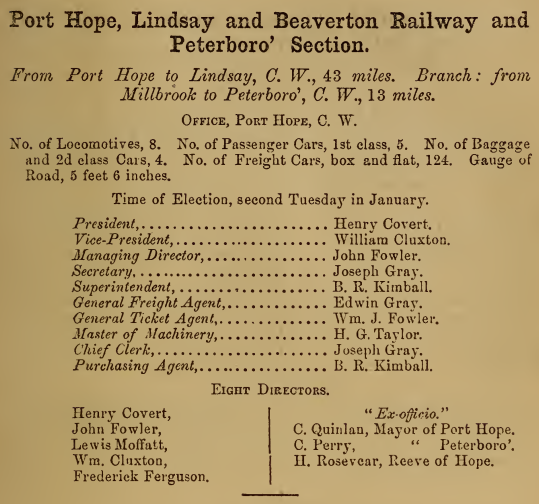
Ashcroft's Railway Directory for 1865
There was little chance that the Port Hope and Lindsay road was ever going to expand into the territory of the Northern Railway under the superintendence of Frederick Cumberland. Therefore, a little ingenuity was necessary in devising a plan to take back control of the road from the bondholders. At the time, a large amount of the bonds were held by the failing Bank of Upper Canada via the Town of Port Hope, and the late contractor of the road Samuel Zimmerman who had taken them as part payment for constructing the road. Henry Covert and Col. D'Arcy Boulton, by way of an "engineous (pardon the pun Col!) plan", were able, in March of 1864, to purchase the bonds held by the bank, worth £80,000, for "the Banks" price, according to Boulton, of £45,000.
After the purchase of the bonds an act was passed by the provincial legislature to reorganize the railway in the summer of 1864. The act stated that the voting on new directors for the road was to be held in early-August. With Boulton, Covert and Fowler now in possession of a large amount of the votes, Covert was elected President and our friend from the Peterborough branch became Managing Director.
Years later the shareholders of the bankrupt institution claimed a kickback of £12,000 was given to the bank's cashier Robert Cassels and brought suit against Boulton and Covert just prior to a vote on a bonus to be given to the railway by the town of Orillia. Boulton said of the affair:
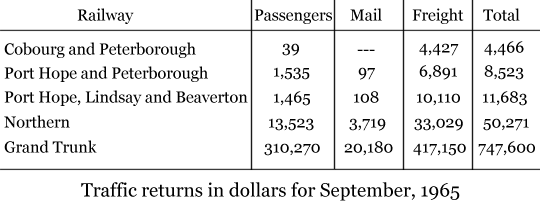
Department of the Minister of Finance
A gross attack upon private character under color of a suit in chancery, has been made by the Plaintiff in the suit and others concerting with him with a view to damage the position of "The Midland Railway of Canada".
In other words, an attack on the Midland road by the Northern Railway just prior to the vote on the bonus. The citizens of Orillia would, in spite of that, vote a bonus to the Midland and not the Northern.
Millbrook and Lakefield Branches
In 1866, as the Port Hope, Lindsay and Beaverton Railway began to prosper under the new management, an application was made by the company to the provincial parliament to authorize the purchase of the old Peterborough and Chemong Lake Railway, and to reauthorize the completion of the mainline to Beaverton.
The Peterborough and Chemong Lake Railway was not complete to Chemong Lake, but did extend north from Peterborough, as an extension of the previously mentioned Cobourg and Peterborough Railway, to lumber mills on the Otanabee River. With an extension of the railway to Lakefield being the reason behind the intended purchase, a provision of the act that followed allowed for the extension of the newly acquired line to mills within four miles of the original P&CL right-of-way. The target mill in Lakefield was owned by the lumbering firm of R & G Strickland.
Coincidentally, and much to the benefit of the future railway line to Lakefield, severe rains during the 1867 spring thaw would wreak havoc on the timber slides and dams on the Trent River making it difficult for the company to get the lumber to market. It would however take until December 1868 before the track would reach Lakefield. It should also be noted that in the summer of 1868, Col. D'Arcy Boulton's daughter Mary married Roland Strickland, co-owner of the R & G Strickland lumber firm with his brother George.
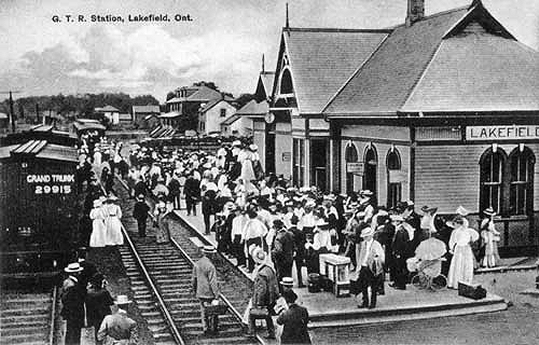
The Grand Trunk(ex. Midland) Railway's Lakefield Station ca. 1910 after G.T.R. remodel.
The Stricklands were a prominent family in the Peterborough and Lakefield area for decades. They would be influential in building the lock upstream from Lakefield at Young's Point that would further increase business for the railway. The lock, finished in 1871, allowed for easy access from the upper lakes to the rail head at Lakefield by timber and lumber rafts as well as a newly built steamship. The previously mentioned Francis Beamish, a past director of the railway and now mayor of Port Hope, built the steamer "Colonel Strickland"(named after Roland and Georges' father) at Lakefield for this purpose. The steamer's name would later be changed to "Chippewa".
For years to come the railway would benefit from the patronage of the Strickland operations from all reaches of the line. Timber and lumber was driven down the Black River and transhipped from Lake St. John via the Northern Railway to Orillia; loaded onto scows at Fenelon Falls and pulled by steamer down the Scugog River to Lindsay; and directly onto the cars from the mill in Lakefield. The majority reaching market via both the PHL&B/Midland Railway and the harbour at Port Hope. Most lumber being shipped to Albany, N.Y., and the timber to markets in Quebec and overseas.
Besides being of convenience to the wood products trade, the Lakefield extension and steamboat would become very popular with excursionists and sportsmen alike:
"The Mount Julien Hotel, on the very shore of Stony Lake, for the especial comfort of tourists and sportsmen, has accommodation for sixty guests, with every luxury that could reasonably be looked for in the backwoods of Canada. Terms $2 per day, $10.50 per week. Sailboats, row boats, and canoes, guides and dogs are always at hand. Go via Rochester, N. Y., to Charlotte on the New York Central Railroad, thence by steamer to Port Hope, thence Midland Railway to Lakefield where the steamer Chippewa is in waiting to convey you to Mt. Julien. Time from Charlotte, fourteen hours, fare $4. Fare from New York about $20 each way."
A second act passed by the provincial legislature at the same time authorized the sale of the Millbrook to Peterborough branch that was partially owned by John Fowler. The said interested party was none other than Mrs. Emily Boulton, the Colonel's wife, on her own behalf and as trustee for her children. The branch from Millbrook to Peterborough was, of course, the railways connection to the soon to be built Lakefield extension.
It is at this time that John Fowler seems to have sold out and moved on to promote a series of unsuccessful railway schemes where he was up to his old tricks. Frederick Cumberland, previous manager of the mainline under the bondholders, would have some revenge at a promotional speech held by Fowler in Toronto for a new railway scheme to Owen Sound. After picking Fowler's "Montebank scheme" to pieces, only a handful of the 500 or so in attendance voted in favour of pursuing the idea further. At a later gathering for a new scheme to resurrect the Cobourg and Peterborough(bridge and all) and extend to Georgian Bay, Fowler spoke of his past achievements as proprietor of the Port Hope and Peterborough Railway, and also of disagreements he had with Colonel Boulton leading up to, or possibly even concerning, the sale of his interest in the road. Unfortunately, no more details of the speech were given in the local newspaper.
Beaverton Extension
More of a completion of the original charter, the building of the extension of the mainline from Lindsay to Beaverton would begin shortly after the completion of the branchline to Lakefield.
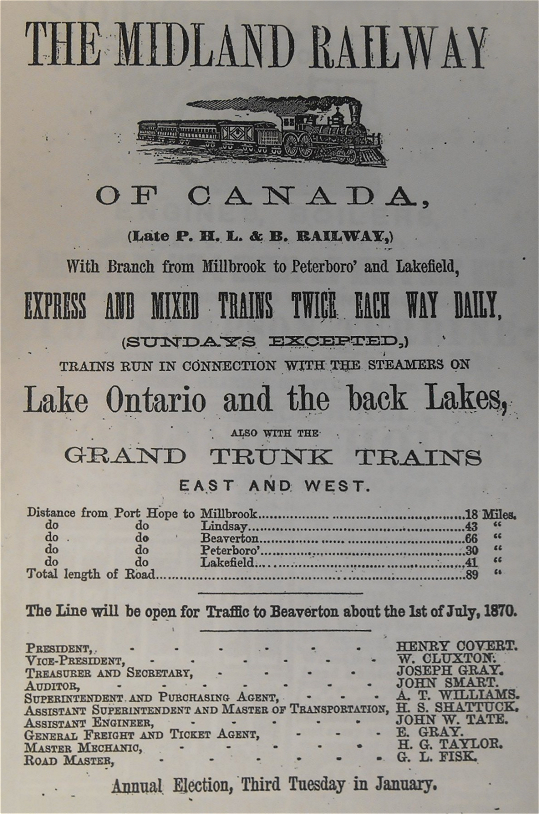
Ontario Directory 1870
In 1862 the population of the railway's terminus, the town of Lindsay, was 2,000 - less than half the population of Port Hope and half the population of Peterborough. It was situated in the midst of very good grain producing farmland. The grain products trade was the second highest revenue generator for the railway. The timber and lumber trade was also very good with the town being situated on the Scugog River south of the large tracts of natural forest. Timber slides and a proper lock at Bobcaygeon provided a means to navigate timber down through the lakes and rivers to the mills at Lindsay. Lindsay had a timber slide with the flow of water heading north into Sturgeon Lake. Consequently, most of the mills were built downstream from the slide as all goods heading upstream had to be unloaded and reloaded to travel further. A timber lock was built in its place by the Provincial Government in 1870. Whereas the Young's Point lock had a beneficial effect on the railway, a consequence of the the newly constructed Lindsay lock was that a portion of the traffic would be continuing upstream to the town of Port Perry and the soon to be completed railhead of the Port Whitby and Port Perry Railroad.
In the beginning, Lindsay, as part of the surrounding Township of Ops, had supported the construction of railway, but the townships to the southeast and west provided no support at all. This contributed to the overall lack of funding and halted construction at Lindsay where the terminus remained for the next 13 years. This was probably not such a bad thing considering the financial troubles that followed the initial construction of the line. The initial charter to Beaverton seemed to be a bit far fetched financially, but no doubt helped gain the additional investment from the municipalities necessary to at least reach Lindsay. Mr. Zimmerman had stated on the opening of the line to Millbrook that it was unlikely that the line would be built beyond Lindsay given the state of the finances.
On the second quest for Beaverton the township of Mariposa once again refused to support the line and as a result the right-of-way was moved to the north to bypass the township's villages. A few years later the township would support the rival Port Whitby and Port Perry Railway on their extension to Lindsay, just to have the line amalgamate with the Midland a few years later. Supporting rival lines to lower rates would often result in another monopoly just a few years down the road when the competing railways failed to pay interest on debts and were forced to collude, amalgamate or restructure.
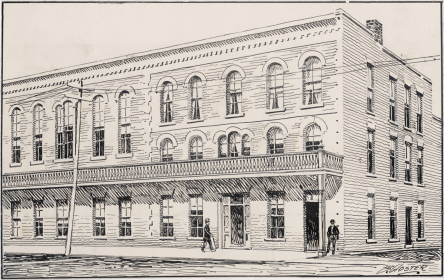
Hamilton House, Beaverton, Ontario
The township of Thorah did however make a substantial investment in the extension of $50,000 that paid 3% interest annually, and once again the Town of Port Hope, forever called upon for support, had also made a large contribution. The contract for the construction of the line was awarded to Noble and McIntosh in March of 1869 and was to be completed to Beaverton by December. Unfortunately, the contract was handed back to the railway only partially completed and it was left to the chief engineer to deal with the subcontractors and finish the line into Beaverton. A condition of the Act authorizing the extension of the railway to Geogian Bay stipulated that the extension to Beaverton must be completed by July 1, 1870. The delay in construction necessitated an extension from the township of Thorah for the completion of the line from July 1st to December 25, 1870. Col. Boulton and his Port Hope entourage arrived in Beaverton by train one day early. At the head of the train was the locomotive "Havelock", one of the first to be acquired by the railway, and one of the first to be produced by the Kingston Locomotive Works. Col. Boulton and entourage were transported downtown, a fair distance from the station, for a brief reception at Hamilton House where dinner was served and a few congratulatory speeches made before being driven back to the awaiting train for the trip back home.
The old Port Hope, Lindsay and Beaverton Railway had finally reached it's namesake.
D'Arcy Boulton (1814-1902) President of the Port Hope, Lindsay, and Beaverton Railway (1971-1973)
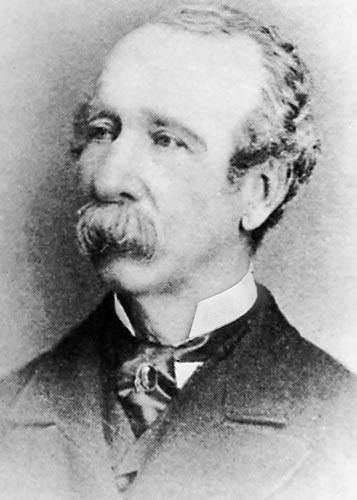
Colonel D'Arcy Boulton
D'Arcy Boulton's uncle George was an original director of the Cobourg and Peterborough back in 1835, as was he when it was rechartered in 1852. George moved to Cobourg in 1824 when he was appointed registrar of the County of Northumberland.
D'Arcy Boulton III, the namesake of his father and grandfather, was educated in Toronto and then studied law in England before moving to Cobourg to set up a legal practice with his uncle George. His family arrived in Canada via New York State at the turn of the 19th century and soon became prominent citizens of the town of York(Toronto) - so much so that they were at the top of William Lyon Mackenzie's list of his privileged "family compact". His father was a lawyer in England before changing direction in Canada, where he became a ruthless grocer and dry goods businessman in York. He built his home, The Grange, on a large parcel of land northwest of the town, which today is well inside the the boundaries of Toronto and the oldest surviving brick house in the city. His mother was well known as a "congenial hostess, whose bright smile and lively conversation put everybody at ease". Conversely, his father was all business with little time for small talk. However, his uncle George, whom he trained under in the practice of law, was said to be of "kind disposition, and good to the poor of the town". New law students of the day, including Sir John A. MacDonald, were said to have trained at his law office in Cobourg.
Col. Boulton, as he was referred to, presumably after being promoted to Lt. Col. of a volunteer cavalry troop he established, was involved, along with his uncle George, in the military history of Cobourg since their arrivals in the town. During the Upper Canada Rebellion, Boulton raised a force of three hundred and was present when the rebels were dispersed at Montgomery's Tavern. His son would take part in the Reil and Northwest rebellions. Col. Boulton seemed to be well in tune with the other military affairs in the province and would talk at length about them at banquets and events. I imagine he would have had a few good stories to tell, including how his grandfather, D'Arcy Boulton Sr., was captured by a French privateer while enroute to England.
Boulton seemed to be at the forefront of railway concerns while associated with the Cobourg and Peterborough and Port Hope and Lindsay/Midland railways. The most negative comment that I have read about him in relation to the railways was that he was a bit of a "rascal", and disliked by some of the directors and many of the employees. During his tenure with the Cobourg and Peterborough he ran, and lost, in an election against fellow director and reform candidate Sidney Smith in the riding of Northumberland West. Both would criticize the others' policies in the local newspapers; that were referred to as "organs" of whomever elicited their services. In Bernard McAllisters "Cobourg Reminiscences", he states that he lost one hundred days of wages while working for the Cobourg and Peterborough when Mr. Boulton had the lease. And although it is hard to entirely fault Boulton when funding was not available, contracts would be taken back if not completed for the agreed to amount, which in general would be the norm rather than the exception when dealing with railway contractors. Neither the Zimmerman contract to build the Cobourg and Peterborough, nor the Beaverton and Midland extensions of the Port Hope and Lindsay road were completed under the original contractors - Cobourg eventually having to pay extras on the incomplete C&P contract.
However, in regards to Col. Boulton there is far more in the positive vein than the negative. He was the Mayor of Cobourg and then a councilor during his association with the Cobourg and Peterborough Railway. Obviously, being in the interest of the harbour and town in general, he tried every effort to keep the road above water, so to speak, after the ice wreaked havoc with the Rice Lake bridge during the (initial) winter of 1855. He was at many of the different railway company functions, be it excursions; pic-nics; gatherings in recognition of current or retiring employees; and front and center at most of the promotional engagements. It is obvious that he was a popular speaker at all of these events, and well liked in general.
In my opinion, D'Arcy Boulton played a huge roll in the recovery, and expansion, of the Port Hope, Lindsay, and Beaverton/Midland Railway, and what little success the Cobourg and Peterborough Railway would have. And although he was only president of the Midland for a short time after Henry Covert retired, he was the key player in seeing the line through to Orillia as well as the branch to Lakefield.
The Colonel would sell his shares in the Midland just a few months prior to the collapse of the lumber trade with the United States in the summer of 1873. Adolph Hugel and Company would be left holding the bag for the next four years as the Midland Railway's income steadily decreased in a very depressed economy.
Georgian Bay Extension
As the Midland was being constructed through the rich farmlands between Lindsay and Beaverton, the campaign to push the road on to Georgian Bay had already begun. A determined opposition from a new rival, the Northern Railway, headed by Frederick Cumberland, was continuous throughout the process. In order for a bonus to be granted to a railway a by-law had to first be voted on by the ratepayers of a given municipality. The Toronto railway men, through questionable conduct, attempted to influence the outcome of the voting or, at the very least, the amount of support given. This seemed to backfire to some degree with the people of Orillia and the northern townships, however influence was also brought to bear with members of the provincial parliament as well. Speaking of the bill to extend the Midland Railway to Georgian Bay, a newspaper paraphrased what Mr. Burton had to say of the affair:
"F. H. Burton, M.P., was in Toronto at the time the Bill was before the house, and he had never before, in the whole course of his parliamentary experience, seen so much organised opposition to any measure as was given to this. The whole press and monied influence of Toronto had put forth every effort to defeat that bill."
On the (previously mentioned) attack against Boulton and Covert regarding the purchase of bonds from the Bank of Upper Canada (back in 1864), the Port Hope Guide had this to say:
"The treachery and villainy of the Toronto opponents of the Midland Railway has finally culminated in one of the most despicable pieces of strategy that has ever been employed in railway warfare. During the voting upon the Orillia By-Law a poster (said to have been printed at the offices of the Northern Light) was placarded throughout the village charging Henry Covert and D'Arcy E. Boulton Esqs., with fraud in negotiating certain railway bonds with the Bank of Upper Canada."
Shortly thereafter the town of Orillia, and the townships of Tay, Matchedash, and Orillia, passed by-laws to bonus the Midland Railway, and by June, 1871 the preliminary survey to Georgian Bay had been completed. The Midland's chief engineer since 1968 was George Stewart of Port Hope. Stewart had previously worked for the Northern Railway under Sir Sanford Fleming and had surveyed parts of Georgian Bay in 1852. He had known the best natural harbour for the railways terminus was Mundy's Bay(Midland Bay) prior to being hired.
The sentiment in Toronto was summed up in what must have been one of the last articles published in the Toronto Daily Telegraph:
A line of steamers placed on the upper lakes by Montrealers, to ply between Hog Bay and Duluth, would secure for the Port Hope line the entire trade of the North-west. It would be carried through this Province back of Toronto, would reach Lake Ontario at Port Hope, and pass on to Montreal either by the lake and river steamers or by the Grand Trunk. Toronto would be completely cut off; and we would never enjoy the trade of the North-west, which we have been counting on with so much certainty of late. This movement against Toronto's interests can only be checkmated in one way. The Northern and Muskoka Railway Companies, aided and assisted by the people of this city, must extend the Muskoka line to Hog Bay, and, if they wish to succeed, they must take preliminary steps at once.
Adolph Hugel and Company
It is at this point in time (July, 1871) that president Henry Covert decided to retire on his means and sell his substantial interest in the Midland line to a group of American, British, and German investors represented by, and including, Adolph Hugel. Covert reaped a handsome profit in the hundreds of thousands of dollars - selling at the perfect time, as the company's fortunes, for various reasons, would begin to soar in the coming years. The new management were setup up well, however, with the authority to issue £100,000 in new bonds to begin construction on the extension to Georgian Bay.
After the new company had taken possession, Col. Boulton was elected president and Mr. Hugel vice-president with some of the old directors and key officers once again onboard. Col. Boulton, who was the company's representative during the Georgian Bay campaign, was obviously the right man for the job based on his positive results to date. It would be hard to imagine the extensions to Lakefield, Beaverton and then finally on to Orillia without his spirited efforts.
With new management in place, the Midland Company lost no time in proceeding with the first phase of the extension to Georgian Bay by giving notice for the need for some 500 hundred men to work on grading the line between Beaverton and Atherley, and the branchline to Lake St. John. Gathering such a work force would normally not be so difficult, however during the 1870s there was a railway construction boom in Ontario and the railroad navvies were becoming very much in demand. Only decent wages and good working conditions could secure a work force for a extended period of time. Navvies were all too willing to run off to the company next door when wages were lowered. At this time, work was underway on the Toronto and Nipissing south of Lorneville as well as on the Northern's Muskoka line running north from Barrie through Orillia. More railway companies intent on competing with the Midland would be under construction in the coming years - depleting the labour market even further.
Notwithstanding, the Midland had 300 men working north of Beaverton by October and one of their engineers, J.W. Tate, had the line permanently located north of Orillia to Coldwater, and was working beyond as several trial lines had already been run to Mundy's Bay. The Northern also had surveyors in the area feigning intent to build a competing road to Hogg's Bay. It was too little and far too late, however, for any hopes the Midland may have entertained in being the first railway to enter the town of Orillia. On November 14th, 1871, Frederick Cumberland of the Northern Railway would arrive on the first locomotive to enter the town - a full year in advance of the Midland.
It is at this time, late in the fall of 1871, that a Cannington newspaper reported that the Midland had reduced the wages of the men working on the extension between Beaverton and Orillia, to $1.00 per day. As a result, the majority of the men were said to have quit the Midland and headed over to the Northern's Muskoka line where they were promptly hired on at $1.37 per day. It was then said that the Northern had circulated a report that construction had been abandoned on the Midland between the two towns. The Midland in reply said that the men had been paid off due to the frost and only the deepest cuts were still being excavated, and that work would also be continuing through the swamps and on the bridges. Adverts requesting tenders for this work and clearing the right-of-way northwest of Orillia were published in December, 1871, but then republished with an "X" across the center.
Naming of "Midland City" in early November, 1871
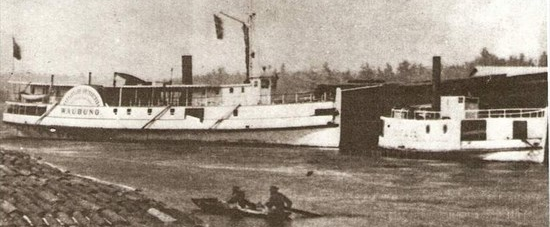
Waubuno and Mittie Grew - Parry Sound Public Library
Mr. Hugel, vice president of the Midland R.R. Co., Mr. Stewart, Chief Engineer, and a few other railway notables, took a trip of observation over the new line, about three weeks ago, and after "taking stock" of the beautiful Bay at the terminus, and the splendid site for the city to be, they wisely concluded that such a place should have a name worthy of it; (and we all know there is sometimes a great deal in a name,) so the above appropriate one was given it, with all the most modern ceremonies, including the traditional sprinkling with Hennessey's best - the crackling of numerous bottles of "green seal" - and a magnificent spread served upon the "Mittie Grew", Mr. Dodges steam pleasure yacht, kindly lent for the occasion.
Francis Shanly
It early January of 1972 the company made a change of direction in regards to subcontracting out the work on the extension. Instead of continuing to do it in-house, as had been the case since the latter part of the extension to Beaverton, the company gave a twelve-month contract to finish the line to one of the countries brightest railroad engineers, Francis Shanly. Shanly had previously been working with his brother Walter on the Hoosac tunnel project in the state of Massachusetts, but with the recent railway boom in Ontario he left the project to take on numerous new consulting and contracting opportunities in Ontario. The Midland project would have Shanly acting as the head contractor that oversaw the entire construction of the line through to Midland Bay, not just as engineer to the subcontractors. He would take the contract on at a reduced rate per mile, based on work that had previously been completed by the Midland Company.
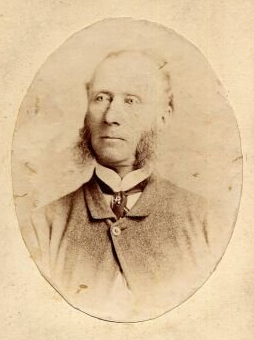
Francis E. Shanly - Wellington County Museum
Besides the aforementioned labour shortage, which Shanly was able manage to some degree by paying higher wages and transferring men from his soon to be completed Great Western Air Line contract, the terrain that the roadbed traversed turned out to be not-so-ideal for grading. One may have assumed, based on the government inspectors report and Mr. Stewart's report, that the terrain was indeed easily graded. However, just north of the Talbot river is a narrow branch of a larger limestone plane, now called the Carden Alvar (that lay more prominently to the northeast). The soil on top of this plane is very thin with very poor drainage that is not suitable for anything but ranching. This would most likely have been known by the company at the time the contract was awarded to Shanly. Today, with limestone being a key ingredient of Portland cement, there are numerous large quarries in the area, including one that sits directly adjacent to the Midland's old right-of-way. In addition to this, most, if not all, of the work said to have been completed by the company was of the substandard variety and had to either be completely redone or improved upon, causing Shanly additional expenses that would have to be charged back to the company.
With numerous irons in the fire, Shanly seemed to be overseeing the Midland project from a distance. It was during the summer of 1872 that he was also nominated as the conservative candidate for Toronto Center in the federal election. Conversely, Colonel Boulton was meddling with the work of the subcontractors in an attempt to hurry the project between Beaverton and Orillia - seemingly knowing that Shanly would not have the opportunity to finish the line to Midland Bay after his twelve month contract had expired. Shanly really had no chance of completing this line in time, as late or non-payment by the Midland Company would cause serious delays from the start:
"the non payment of estimates in the spring and early part of the summer caused a number of men to leave the work and one of our best subcontractors. Thereby causing work to be done in the fall and winter months which could have been done in the summer."
Just one of a long list of complaints against the Midland by Shanly & Company during the construction.
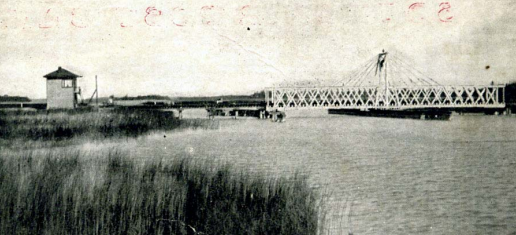
Atherley Narrows Swing Bridge - Unterman McPhail Associates
Nevertheless, Shanly and his agents reorganized the project and had the iron laid into Orillia by the end of November. The Atherley Narrows swing bridge and Talbot river bridge, contracted to J.& A. Myers, were also complete by this time. Credit for the design of the swing bridge, said to have been of better design than the Northern's at one-tenth the cost, goes to the Midland companies chief engineer Mr. Stewart. Estimates for the Midland bridge ranged between $5600-$8400, and one source claimed the cost of the Northern bridge was $85,000.
Despite the company's efforts to shift labourers over to the Beaverton-Orillia extension, it should be noted that much of the work done by Shanly's men was between Orillia and Midland Bay. His notes show subcontractors working on every section of that part of the extension - however, in most cases struggling with a shortage of labourers. For a days work on the embankments leading up to the Talbot river bridge, on the Beaverton-Orillia extension, Shanly paid 20 men a pricy $1.50 each, 4 boys $0.75 each, and $2.00 each for a pair of horses. One of Shanly's subcontractors on a section just north of Orillia, George "Shields", would later have a track siding named after him near the cut he made at the Muskoka Road crossing (now Hwy 11).
At the end of March, 1873, with the Midland unable to pay expenses and second mortgage bonds supposed to have been taken in payment unmarketable, Shanly abandoned the contract. He would later give a general briefing of his troubles with the Midland company to bondholder trustee Lewis Wallbridge.
Government Grants and Running Rights
One of the ways in which a company could get financial aid for building a railway was via a government grant. This would be applied for by the company and the government would determine how much, if anything, it was going to grant (to a maximum of $4,000 per mile) based on a number of factors. If a line was considered a "competing line" (i.e. a parellel line to the same location as a previously built line), there would be no grant money available. Such was the case for the Midland's proposed line to Lake St. John and the Northern's branch line from Orillia to Georgian Bay - even though the Midland was authorized to build to Lake St. John first and the Northern's scheme to Georgian Bay would probably never have been built. Another company, Belleville's Grand Junction Railway, also wanted running rights over the Midland from a junction between Omemee and Lindsay to Georgian Bay because they, as a competing line, would not get government aid to help finance such a project (when and if they would ever reach Omemee which they never did). So in order for the Midland to obtain a grant for $3650 per mile between Orillia and Munday's Bay it would have to give running rights over said line to both the Northern and the Grand Junction. Reciprocal running rights over the five mile stretch of the Northern, to the timber portage at Lake St. John, was of little value since the proprietor of that operation was already rafting the logs down to the Midland and was intent on doing so even after the Northern had reached that location. The Northern would get the maximum 4,000 per mile from Orillia to Washago for allowing the Midland running rights on that line.
Consequently, Col. Boulton thought it best to refuse the government aid and once again turn to the town of Port Hope for assistance. The plan this time around was for the town to give the railway all harbour tolls collected on freight originating from north of Orillia, which would include the Lake St. Johns traffic, for a period of ten years. This time however there was some push back from one of the local newspapers that had recently soured on Col. Boulton and the idea was subsequently dropped. The Midland would receive $2650 per mile in grants without running rights to the Northern, and still have to grant running rights to the Grand Junction. Payments of the grant money would not be paid until the road was at least complete to Waubaushene.
Opening of Rail Service to Orillia
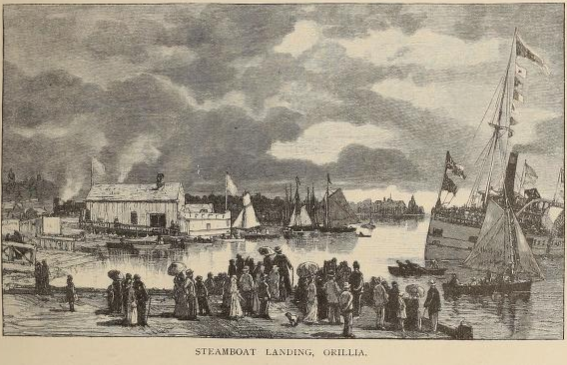
From the book Picturesque Canada, 1882
The train left Port Hope at 12pm on Thursday, Feb 6, 1873 with guests invited to a banquet held in Orillia for Col. Boulton and the directors of the Midland Railway. At Woodville Junction(Lorneville), Mr. Gooderham of the Toronto and Nipissing Railway boarded the train and it arrived safely in Orillia at around 6 p.m. Banners on the walls of the banquet hall read "Welcome to the Midland Railway"; "God save the Queen"; "Railroads and Progress"; "Welcome to the Nipissing Railway" etc. Oddly enough, Col. Boulton had to apologize for Mr. Hugel, vice-president of the Midland, for having missed the train to the event.
Seemingly a popular speaker and person in general at company pic-nics, excursions, and ceremonies such as this, Boulton must have had a small town character about him that helped him win over the populace of these rural communities. This would, however, be his last speaking engagement on behalf of the Midland, and he probably knew it at the time. He spoke about his earlier railway endevours from the turning of the sod on the Cobourg and Peterborough in 1852, to his present time with the Midland and how they were the first to propose building to Orillia. He had formed an amicable relationship with the Toronto and Nipissing in securing a connecting link to Toronto, and held out an olive branch to the Northern in saying the future grain trade of the Midland would not tread on the company's toes, and that there was room for both railways in Orillia. He then stated that he had no greater ambition than to benefit his country and others while at the same time doing something for himself.
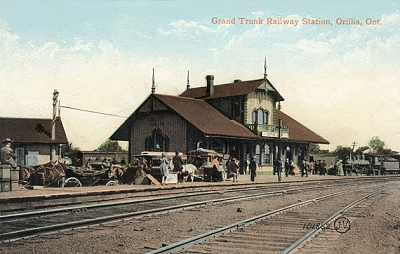
Former Midland Railway Station, Orillia - relocated here in 1897.
The above picture illustrates the Midland Railway wharf and warehouse at the foot of Mississaga Street as it was a few years after the Midland Railway arrived in Orillia. A causeway across the harbour was built by the Midland to bypass the built up downtown area. The resulting pond in the middle was later filled in by the railway on demand by the town, and the isolated boat liveries, also the responsibility of the railway, were reconstructed lakeside. Years later the Canadian Pacific would do the same, extending the shoreline out even further. Where Laclie Street south now ends is where the shoreline once curved around. The wharf was purchased by the railway from Captain May, who at one time owned the steamer coming into dock at the right, named the Emily May after his daughter. The steamer was renamed "Lady Of The Lakes", as you may vaguely see in part by the sidewheel, and operated by the Northern Railway on Lake Simcoe. To the left of the wharf you can see a Midland engine coming in from the west, and to the rear right on the point, the Orillia Idiot Asylum.
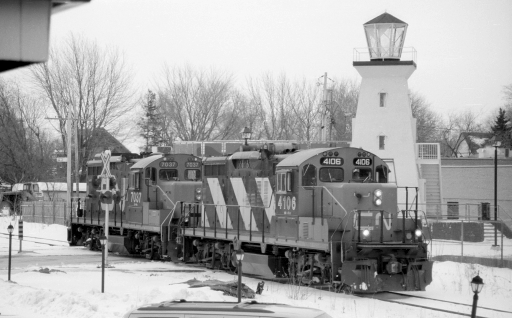
Mississaga Street crossing 1995, site of Midland Station, Turntable and Engine House - B&W Photo by Author
In 1873 daily service consisted of a mail(mail/passenger) and mixed(passenger/freight) train departing and arriving, to and from Port Hope, at Orillia. An additional freight train arriving and then departing at Lindsay, from and to Port Hope, was also scheduled. The daily mail arrived and departed mid-afternoon, and the mixed left at six in the morning and returned later in the evening. The station was originally adjacent to the engine house until the new station, pictured above, was constructed on the opposite/north side of Mississaga street. After the takeover of the North and Northwestern Railway(the merged Northern and Hamilton and North-Western) by the Grand Trunk, there was only the need for a single station in town and it was decided to relocate the Midland structure a few blocks south to the old Northern line at Midland Junction and Front Street. The station would burn in 1916 and, despite a desire by the citizens to have the replacement built at the foot of Peter Street, the new building was constructed at the same location and survives to this day.
Adolph Hugel (1828-1899) President of the Midland Railway of Canada (1873-1878)
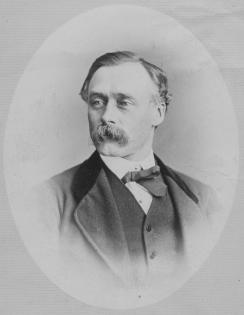
Adolph Hugel - McCord Museum
Adolph Hugel, born in Germany, came to Canada via the United States. Prior to investing in the Midland Railway, Hugel was partnered in both a freight forwarding and a malting business in Philadelphia, Pennsylvania, and then later, or possibly concurrently, owned (what I believe to be) a barley distribution warehouse in the state of New York. The freight forwarding business had a contract to manage the through traffic for the Williamsport and Elmira Railway and Reading Railway northwest of Philadelphia, and presumably dealt with all of the railways carrying through-traffic from the northwest into that city. The businesses were connected to some degree, as barley is processed to make malt, and at the time the American Maltsters preferred Canadian barley over their own product, requiring a connection to be made north of the border to import the grains into America. Once the grain was imported, it would be distributed to the malting houses and processed into one of the key ingredient in beer and spirits. Importing barley, or through-traffic to Philadelphia in general, could be how Mr. Hugel came to have his connection with Canada, or even the Port Hope, Lindsay and Beaverton Railway directly.
Having lived in the Rochester, New York, area prior to moving to Canada, he was likely to have made a trip or two from that port across the lake via steamer to Port Hope, and possibly even taken an excursion up to the back lakes via the Port Hope, Lindsay and Beaverton Railway. Hugel's wife was sick in an institution in Avon, New York, and would, presumably, pass away prior to his leaving for Canada, as he was described as a bachelor during his complimentary excursion to Stoney Lake immediately after becoming president of the Midland in 1873.
Upon acquiring an interest in the Midland Railway, Hugel purchased land from William Henry Beatty at the railway's terminus and partnered with him and others in the creation of the Midland Land Company. He was elected president of that company for a brief time before resigning the post. A main east-west road in the Town of Midland, Hugel Ave., bears his name.
Hugel's tenure as president of the Midland went from bad to worse starting with the collapse of lumber exports to America in the summer of 1873. He was, however, determined to push the road through to Georgian Bay and in the process caused the company's financial collapse. Although his extravagant spending habits did not help, the money was at least spent on what he believed would further the cause of the railway, and his intention was to eventually pay the money owed back. In the end, however, the employees of the company would strike for their back wages and refuse to work for him, and with the overall indebtedness of the company at the breaking point it became necessary to reorganize. Hugel would resign his position, and bondholder trustee and vice-president of the company, George A. Cox, would be appointed president.
During the the years that followed, Mr. Hugel, as a shareholder, sat through many a meeting that must have been somewhat uncomfortable. His successor, Mr. Cox, would make a few patronizing comments before going over the ruinous state of the company when he took control. At a banquet in Port Hope, attended by Mr. Hugel, the Mayor of Lindsay expressed that the town would have never bonused the other roads if the Midland had not been managed so poorly; absolving himself of any responsibility for the downfall of the road and Lindsay's debt.
In 1881, Mr. Hugel was nominated for Mayor of Port Hope for the following year but declined, gracefully stating that he had another child to father, the Midland Land Company, and that his dream was to become the first mayor of the town of Midland. Hugel would, however, take on the job the following year.
Mr. Hugel spent his final years living in downtown Montreal at the Windsor Hotel, were he seems to have been on a limited income and involved to some degree with an importing company. Even upon his death it was thought appropriate to make reference, in a Lindsay newspaper, to his lavish spending as President of the Midland Railway.
Boulton Bought Out by Hugel and Company
Notice was given through March and April that a special meeting of the Shareholders of the Midland Railway was to be held on April 27, 1873. Days later it was announced that Colonel Boulton has sold out his interest in the Midland for a good profit and that Adolph Hugel had been elected president of the road.
No sooner had Mr. Hugel taken charge than he placed adverts in many of the papers giving notice of the cancellation of passenger service between Beaverton and Orillia. At the same time the notice was published, a news article was also published stating three trains left the track at the same place on the same day. It may, however, have also served to mitigate some of the claims made against the company by Francis Shanly, who in March had finally given up work on the extension.
During his tenure as president of the Midland Railway, if it wasn't for bad luck, Hugel would have had no luck at all. To begin with, the lumber trade and economy in general was about to fall into a deeply depressed state.
"The price of lumber has fallen twenty-five percent, owing to the failure of the lumber corner at Albany. It is openly stated that the Phelps and Dodge concern is irretrievably ruined. Mr Dodge, M. P. for North York, who was only their agent, is expected to go down with them."
And so began a worldwide recession referred to in North America as the Long Depression(1873-1879).
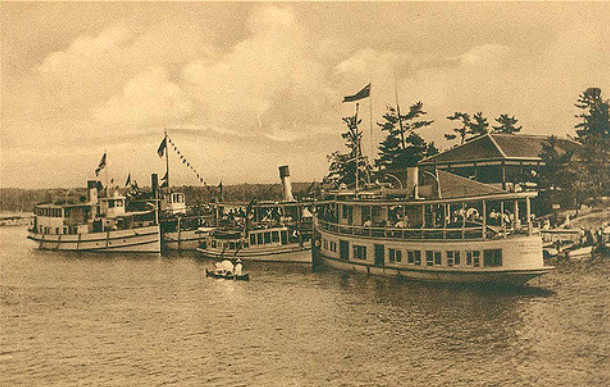
Juniper Island, Stoney Lake
Despite looming financial difficulties, Hugel set forth in organizing his first and grandest excursion into the back country. It was to be a "thank you" to the many friends and associates he had come to know in the country. The Toronto based invitees had begun the trip on the steamer Norseman which delivered them safely to the wharf at Port Hope where they would attend a "Ball at the Music Hall" that continued late into the evening. On Tuesday morning, the guests boarded a special excursion train that would take them to Lakefield via Peterborough and the scenic extension along the Otanabee river. At Lakefield, the excursionists transferred to the steamer Chippewa for the last leg of their journey up to a beautiful island on Stoney Lake, where Hugel wined and dined his quests with the band of the 46th regiment playing in the background. Most of Hugel's guests were very prominent citizens of Ontario including the very first president of the Midland/Port Hope and Peterborough Railway, Mr. David Smart. Although it is impossible to accurately access how much all of this goodwill would directly or indirectly benefit the Midland Company's bottom line over the next five years, the money may have been better spent on interest payments. The one thing that is for certain is that every one of the guests had a "happy time spent with the President of the Midland Railway."
Besides some meetings and a by-law vote regarding bonuses for a proposed branchline to Bobcaygeon that never materialized, the next event for Mr. Hugel and the Midland would be the "reopening" of the line between Beaverton and Orillia. Once again, the train set off from Port Hope with numerous dignitaries, making stops all along the route to Orillia to pick up more notable members of the towns and townships. At Millbrook, the Mayor of Peterborough, George A. Cox, future director, vice-president, and finally president of the Midland Railway, along with the entire town council of Peterborough, boarded the train to partake in the event. Upon arrival at Orillia the reeve of the village, James Quinn, thanked Mr. Hugel and the directors of the Midland Railway for showing prudence in closing the traffic to passenger service until all could be got... back on track, so to speak. The party then proceeded to the Queen's Hotel where dinner was served and the usual speeches were made. Mr. Quinn again spoke and said great credit was due to the late President, who he was sorry was not present, for his efforts. Mayor Cox then:
"congratulated Orillia on the event of the day, and hoped it would contributed to its advantage. In '58 the first train was run into Peterboro', then a small wooden village; but now is one of the best towns in the Province, an expected at one distant day to become a city."
Change of Track Gauge
The standard railway gauge in Canada, called the "Provincial Gauge", at the time the Midland was initially built to Lindsay was 5ft 6in from rail center to rail center. The difficulty, or advantage depending on where the trafiic was headed, was that the standard gauge in the United States was 4ft 8in, making it necessary to unload and reload freight whenever a transfer was necessary to a U.S. railroad. This did not really effect the Midland as all of the freight bound for the U.S. would be unloaded at the harbour or transferred to the Grand Trunk Railway in Port Hope. A problem did arise however when the Grand Trunk converted to the U.S. standard gauge (at Port Hope) in October, 1873. As a temporary stop gap, a third rail was put in place between the Midland yards and the Grand Trunk station to better facilitate the exchange of freight and the movement of newly build rolling stock from the Midland Car Manufacturing Company. As the Midland Railway finally began to prepare to implemented the conversion to standard gauge, four of the newer engines were sent off, in November, to the manufacturer in Portland to be modified to run on the smaller gauge track.
Seven months later, in 1874, the track gauge would finally be changed in a two phase operation. The back sections of the line on Saturday June the 13th, and between Port Hope, Lindsay and Peterborough on Monday, June 15.
Building to Waubaushene
Few signs of progress during the early part of 1874 were published in the press other than a contract given to the Reeve of Orillia Township for all of the ties, culverts, and cattle guards to be installed between Orillia and Waubaushene. Hugel and company were looking for aid over and above what was authorized by the government, which included running rights to the Grand Junction between Lindsay and Midland. Once again the company would turn to the town Port Hope for aid; this time in the form of harbour debentures worth 75,000 in exchange for second mortgage bonds held by the company that they could not sell otherwise. The town initially placed four conditions on Hugels plan, a)money to be spent on iron rails; b)interest on bonds guaranteed by government; c)security given for repayment in 20 years; and d)the company give security to grant no running rights to the Grand Junction or any other railway. Hugel refused the aid based on the amended conditions stating that the debentures were only worth 65,000 on the market and that the aid would amount to little without the free gift from the government and all the future interest to be paid to the town.
In order to change the views of certain members of the Town Council and Harbour Board, Hugel naturally offered up an invitation to members of their joint committee to take part in an excursion to Midland Bay, so that they could see for themselves the great need for rail service in the area and by the lumber industry in particular.
"Last week Port Hope shook off its slumbers at the unusual hour of 4:30 a.m., to go to that much talked of place--Midland: Mr. Hugel, the President of the Midland Railway Company, having invited the Joint Committee of the Town Council and Harbour Board to come, with their friends, and see the wonders of the Georgian Bay. On reaching the station, we saw the "A. Hugel", one of the new and powerful locomotives gaily decorated with flags, pulling to and fro; while the band of the 46th discoursed most eloquent music on the platform. At last the word is "All aboard" and slowly and majestically we moved out of the Station. Time 5 a.m. Making one or two stoppages to pick up some township dignitaries, in a short time we have our compliment of about 130, all told, and rattle along smoothly and evenly for some time. Soon, however, those wishing to to get into the forward car had to acquire sea-legs to accomplish this in safety. The goal being one decidedly worth striving for, we made a determined effort, and meet with the rich reward in the creature comforts so ably dispensed by our commissary, Mr. Tempest. At Woodville, we made a tolerably long stay, rendered agreeable by the opportunity thus given of stretching our legs, and having a little music. With regard to the latter we may remark that our well known Band fully sustained its reputation, both to musical ability, and willingness to play when asked. Past Beaverton without stopping, and onwards towards Orillia, which we reach well in body and mind about 10 a.m. As Orillia is to be visited on the return journey, the several teams waiting near the Station soon get their respective freights and are off for Coldwater; this string of wagons, twenty in number, spread out on the road a good deal, and it is well that this is so, for had they been close behing each other the dust would have been insupportable; as it is we get along well enough to Price's Corners, were some stop and wash some dust out of their throats, others going on as far as Warminster, some two miles beyond, for that purpose. Here we meet Mr. Hugel, who advises pushing on in order to get back to Couchiching that night; after, therefore, a good pall of beer, we proceeded on our journey to Coldwater, which is reached about 1 p.m. Here all sorts of gloomy reports are afloat, the Waubano has burst her boiler, the tug has done the same to her cylinder, and the scow is not to be got; disregarding all of these croakings we push on to the wharf, and find tug and scow in good condition.--About 2 p.m. we embarked for Waubaushene on the scow towed by the Maid of Midland."
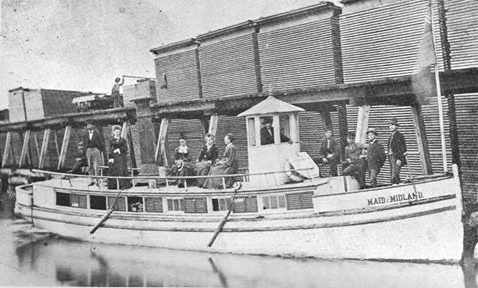
Maid of Midland - Steam Tugboat
"Before starting, however, Mr. Hugel, in a short speech, introduced Mr. Coulson, the Reeve, and Mr. Rutledge, ex-Reeve of Medonte, who briefly explained the views of that municipality on the subject of granting a bonus to the Midland Railway. Neither of them, we may remark, held out much hopes of such a thing coming to pass, although Mr. Hugel seemed rather sanguine on that head. Mr. Coulson eventually went on with us. Proceeding down the river, we become painfully aware that the dog-days are recurring, and we hail with thankfulness the appearance of some bottled ale, brought up by our worthy-caterer from some secret supply. On getting into Duck Bay, the first open water at the mouth of the river, we are taken under the wing of our little tug, and for the first time a little breeze began to fan our cheeks. Soon after, the Prince Albert of Waubaushene comes puffing up and takes hold of us on our starboard side. Between these two we begin to move through the water at a good pace; and soon the funnel and the mast of the Waubuno heave in sight. In a few minutes we are on board of her, and all hands, at the request of Mr. Buck, the superintendent, go on shore, to inspect the vast mills at that place. These mills have a capacity of about 20 millions of feet in a year, but are only working at about 14 millions, on account of the difficulties of transporting the lumber away. Mr. Buck very kindly gave every information with regard to these mills, as also to the others, such as the Severn, Hog Bay, &c., which would be tapped by the Midland Railway. After about an hours stoppage, we started from Waubaushene to Port Severn, taking Mr. Buck with us. At this place we made a short stay. The mills at this place were briefly inspected, and for the education of our readers we give the following short account of them: owned by the Georgian Bay Lumber Company (as are those at Waubaushene); and they have a capacity of 24 million feet annually, but, as at Waubaushene, are turning out considerably less, probably not more than one-half."
"Leaving the Severn, we headed for Midland. There seemed to be but one opinion among the party, with regard to the journey, that the lumber traffic to be derived from these mills on the Georgian Bay was enormous, far beyond their most sanguine expectations; that the scenery of that region was surprisingly lovely; and that the arrangements for transporting such a numerous party were perfect, these latter having being thus ably carried out under the direction of Mr. Tate, C.E., the Assistant Engineer of the Line."
"We arrived at Midland about 6 p.m., and the party separated, some going to the mills owned by H.H. Cook, Esq., M.P., and others strolling about the village, were soon they appeared to be quite at home, the inhabitants in every case entertaining them most hospitably. Through the courtesy of one of the gentlemen at the mills, we are enabled to give the following short account regarding them:--The amount capable of being turned out, working night and day, is about 30 millions; by day alone 20 millions; but on the same account as we have mentioned with regard to the other mills, they are working only half-time. As Mr. Cook has only had this establishment running for about 18 months, during the whole of which time he has not shipped probably more lumber than he could in one month, it may be easily imagined what a boon the construction of this line will be to him."
"A beautiful night succeeded this very pleasant day, and at a decent hour the excursionists sought their couches, some on the boat and some on the shore"
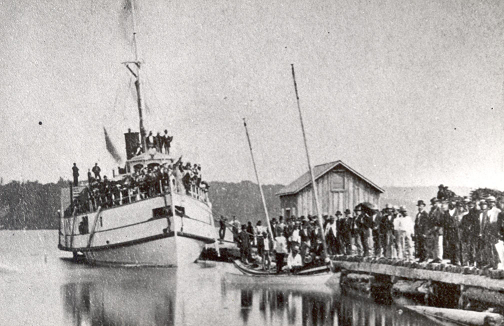
Waubuno Excursion
"About 9 o'clock on the following morning we started for Penetanguishene, but on account of want of time, we suppose, did not get beyond the Reformatory, where we took on board Mr. Kelly, the Warden of that institution. And now we were once more homebound. On nearing Waubaushene a heavy thunder squall, accompanied by drenching rain, struck the vessel, giving her a pretty smart rap; but the Waubuno has seen that sort of thing before on Lake Huron, and therefore did not mind it, although the mouth of Matchedash Bay, full as it is of rocks, is not the nicest place in the world to catch bad weather in. Had this happened at Midland, it would have given those unacquainted with the fine qualities of that Bay, as a harbour of refuge, a splendid idea of the little effect the heaviest storm has on it's waters. We waited at Waubaushene for the storm to go over, and then took ignominiously to our scow and were towed to Coldwater, where we found our teams waiting for us, and proceeded without accident to Orillia. The majority of pleasure seekers returned home by special to Port Hope, a select few being invited by Mr. Hugel to the Couchiching Hotel, where they spent the night and part of the next day, returning to Port Hope by afternoon train. Thus ended one of the most pleasant excursions it has ever been our fortune to witness, and one in which not a single misadventure took place."
It could have been that Hugel wanted the by-law for the aid passed sooner rather than later, and for paying something other than for cattle guards and iron. Do to the slumping lumber trade and expendatures on the change of gauge, including five new locomotives from Portland and other maintenance related issues, the company was about to default on the bondholders interest payment.
Bondholders Tighten Control
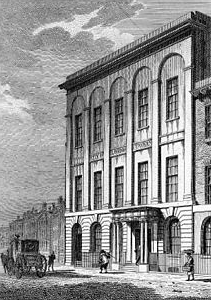
The London Tavern
Upon missing the interest payment, Mr. Hugel traveled with Mr. Frazer to London, England, to face the bondholders at a meeting held at the London Tavern on Bishopsgate Street. Hugel and the Midland directors had a plan to forge ahead and complete the extension that would require the suspension of the annual interest payments on the first and second mortgage bonds, plus the money put aside for the eventual repayment of the bonds. The interest being given in second mortgage bonds that the company could not sell the balance of. More than a few of the Bondholders, angry at money spent on the aforementioned items related to the change of gauge etc., were leaning toward foreclosure, but it was then suggested to make up a committee to further investigate the company's finances and prospects of reaching Georgian Bay, and so they did. Mr. Hugel, prepared to answer to all question related to the railway difficulties, had also supplied information gathered by the recent second mortgage bondholders inspection of the line. It was then concluded by the committee that it was in the best interest of the bondholders not to foreclose on the company and to agree to the terms, as stated above, for the purpose of completing the extension to Georgian Bay. Interest payments would be deferred for three years for the first and second mortgage bondholders, and the sinking fund until March 1st, 1879.
However, trustees would be put in place as directors of the company and the voting privileges of the shareholders, mostly located in Canada, would be forfeited to the bondholders so that they would hold the balance of power in elections - there always being two of a maximum of five directors elected by the bondholders. Weekly reports on the company's finances were also to be provided to a new company agent in London.
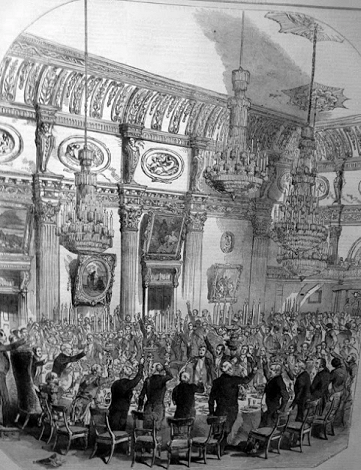
Interior of the London Tavern
"The two Directors appointed at our request and with our approval are T.C. Wallbridge Esq., Belleville, and G. A. Cox Esq., Mayor of Peterborough. The company has also appointed as their agent in London, Mr. Edward J. Halsey, of 79, Cornhill, London, who will for the future furnish the bondholders with information as to the Company's affairs."
It was also in 1874 that the first rumours were afloat regarding the purchase of the Midland Railway by the Grand Trunk Railway. Years later it was thought that Mr. Cox was working on behalf of, and being finacially backed by, the Grand Trunk Railway in order to gain control of the Midland at the time when the Canadian Pacific Railway was building a rail network through southern Ontario. Mr. Cox later stated that he was working primarily in the interest of the town of Peterborough.
The bonholders would also refuse Hugel's plan for aid from the Port Hope harbour debentures just prior to the public vote on the by-law. So much for the excursion. Hugel certainly did not help the cause when at the bonholders meeting he stated "They (Port Hope) are willing to give us help, but they wish to take advantage of our difficulties." When Hugel would again appeal to the town for aid during 1875, a group who strongly opposed the idea applied for, and were granted, an injunction from the Court of Chancery to stay the voting on the by-law due to a technicality. It was later learned that Hugel, "disgusted with the way in which Port Hope has treated his repeated applications for a bonus of $75,000 to assist in the extension to Midland City, is threatening to remove the head office and workshops of the line to Lindsay on receiving a liberal bonus." It would have to be a very large bonus, and then only on the approval of the trustees.
Extension Completed to Waubaushene
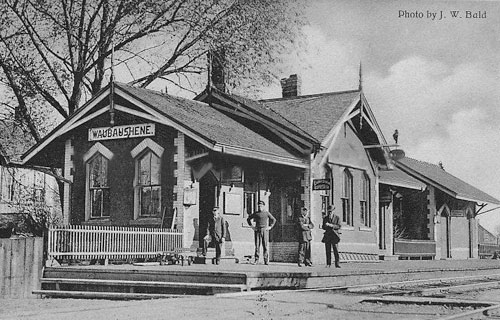
Former Midland Railway Station Waubaushene
In addition to the previously mentioned financial help in aid of the completion of the line to Waubaushene, Mr. Hugel was also able to wring out a bonus from the township of Mara for $12,500. The township, which is located between the Talbot river north of Beaverton and the narrows between lakes Simcoe and Couchiching, had initially refused aid to the railway when building through to Orillia. Former president Boulton had in turn refused railway service to the township which forced residents to travel to Orillia or Beaverton to ships their goods - and no doubt pay a toll to cross the narrows swing bridge. There being as a result no stations in the township, a condition of the by-law to aid the company was that the company build at least two. With the railway being constructed into Waubaushene at the same time as the Brechin station in Mara, both have a very similar Gothic-style design with unique plank gable braces and pointed arches. The designs were unique on the line to the Hugel presidency.
During the summer of 1875 the first construction trains were making there way into Waubaushene, with the first freight said to have been extracted on Aug 11th. A reporter made another trip into town, on Oct 6th, to witness the engine being turned for the first time on the new turntable. Having a turntable built at Waubaushene was a sure sign that the funds necessary to push the road through to Midland were not available.
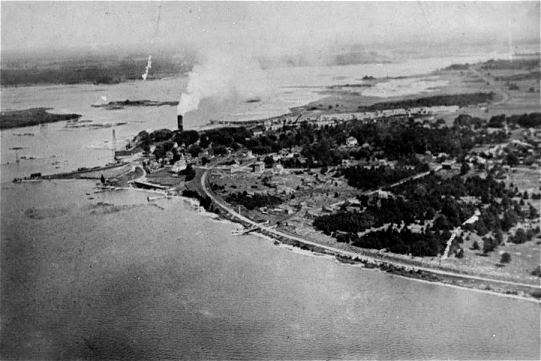
Looking southeast toward Coldwater from Waubaushene, railbed at shorline
The problem with Waubaushene being even a temporary terminus for the railway was that the channel leading down to the village from Victoria Harbour is full of rocks and not very deep. The village is located at a point along the line were the granite of the pre-Cambrian shield meets the sandhills to the south. Navigating a large steamer or schooner in rough conditions would have been a challenge, whereas Midland bay is normally windward with a much deeper bay. Today, with the lowering of the water levels, it is not even possible to navigated through Matchedash Bay to Coldwater in anything but the smallest craft.
With the economy in the doldrums the company was forced to find other means to increase revenues and therefore turned to organized travel excursions for the general public - just as the steamers on lakes Simcoe and Couciching were forced to do after the arrival of the railways. After the line had opened to Waubaushene, a massive trout that had been caught there, weighing 36 pounds, was shipped over the line to friends in Rochester, New York, with a challenge to produce a larger one! Perhaps a group of anglers from that place would be enticed to spend some money on a grand excursion across the lake and up the Midland Railway to the shores of Georgian Bay.
Quest for Midland Bay
Nothing is so difficult as a beginning except, perhaps, the end, and this remark is particularly applicable to railway enterprises; but we feel certain that the ability which has hitherto characterized every effort of the President of the Midland Railway in its behalf, will not desert him now, that the end is almost within his grasp.
In 1876 Hugel and Company along with some municipalities petitioned the Government for further aid on top of what had previously been granted. The argument being that the Northern Railway had received the maximum $4,000 per mile in grant money north of Orillia and the Midland only $2,250, and that the $950,000 already expended on the extension (from Beaverton) would only gain the through-traffic from the west upon reaching Midland City. The grant applied for was the balance of the maximum, being $1,750 per mile, from Orillia to Midland Bay. The Government responded with an additional grant of $1,750 per-mile, but only for the remaining 14 miles between Waubaushene and Midland.
More difficulties due to increased competition around the Lindsay area would soon reduce the benefits of any traffic eminating from the Georgian Bay region. The Whitby and Port Perry Railway had initiated an extension to Lindsay, and construction was already underway on the Victoria Railway north from Lindsay to Kinmount. With the Victoria Railways eventual connection to the Whitby line at Lindsay, some of the traffic normally transferred to the Midland would likely be lost. Hugel would also have to lower rates prior to the completion of the Whitby, Port Perry, and Lindsay road in order to retain business. The town of Lindsay had enthusiastically given bonuses to both roads, which they would come to regret in the coming years. The town had granted the Victoria road a bonus of $85,000 in the belief that it would eventually make a connection with the Canadian Pacific somewhere in the vicinity of Mattawa, however the company had no such funding to advance further than its eventual terminus, the village of Haliburton; the government funding would go to the Northern Railway's subsidiary building north from Gravenhurst to a connection with the Canadian Pacific at North Bay.
At the end of 1876, receipts for the year were $272,954.96, down $11,367.88 from the previous year. Although the shipments of grains in the winter were up substantially, the main staple, timber, lumber and shingle traffic, continued to dwindle during the spring and summer months. The lumber/timber traffic, under Hugel's presidency, had declined during the past four consecutive years to the point where General Merchandise had exceeded it in receipts. Total traffic in this trade, despite the extension to Georgian Bay, being down 60% from 1871. As a result, Hugel was able to obtain a reduction in Port Hope harbour tolls for the following year.
A Damning Report
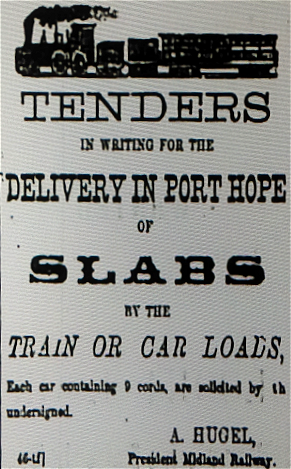
Peddling Coordwood in Port Hope
In November of 1876, Thomas C. Wallbridge, one of the directors appointed by the trustees in London, attempted to expose the Midland Companys accounting practices and overall poor management at the bondholders meeting held in London. Mr. Wallbridge seems to have been a no-nonsense type who was doing his job, without influence, on behalf of the bondholders. With the vast majority of bondholders residing all across Britain being represented by proxy at the meeting, it seemed to Mr. Wallbridge that the meeting had been stacked against the bonafide bondholders present. Nothing was allowed to be brought forward in regards to accusations against the company, which included falsification of the second bondholders agent's report at the last meeting in 1874; recently departed secretary treasurer Mr. Greys evidence as to Mr. Hugel's system of bookkeeping, including false entries and additional damning evidence from recently departed chief engineer, Mr. Stewart. Mr. Wallbridge was convinced that the current trustees were merely agents of the company:
"Mr. Surtees announced that he would go out next spring and look after matters himself, if he do so it will only be another shuffle to cover from the bondholders the impending exposure. This is then the class of men I have to contend with; and of course they are put forward to cover the ring in the back-ground."
"Place the Midland under practical railway management, with a proper account of its income and expenditure, as it had during the accountantship of Mr. Grey, and its difficulties will disappear. We should hear no more of strikes, wages, warrants, detention of cars, daily settlement of accounts of other roads, detention of cars for charges, and the peddling of coord-wood about the streets of Port Hope, &c."
It seems that the Midland was down to a one-day credit with the Grand Trunk and other roads when transhipping freight over their lines, and even that was often in arrears causing many delays in the transportation of goods.
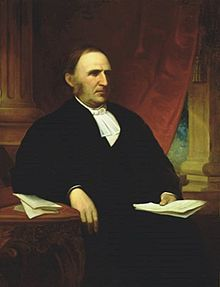
Lewis Wallbridge
Thomas Wallbridge had resigned his position the previous May, and was replaced by his brother, Lewis Wallbridge. The following exert from an article regarding the employee strike in January of 1877, mentions Mr. Wallbridge as the only director of the company the employees were willing to work under:
"On Thursday of last week, the section men along the whole line of the railway, to the number of about 120, struck work; their grievances of wages in arrears, and promises broken by the management repeatedly, having become so pressing that no other mode than a general strike seemed possible to them to compel some attention to their claims. Payment of its employees by means of orders, or scrip was instituted by the company months ago, and the shop keepers of Port Hope and elsewhere were in the habit of cashing this scrip, at a loss, however, to the men of so much per cent. But, getting their wages paid by even this expensive method was destined to stop, for the merchants began to find that they could not get their script cashed, and therefore declined to receive more of it."
"Last week, we are told, the men came into Port Hope in force, and clamouring for their wages, surrounded the station is such a way that trains could not pass."
"They declined to resume work under Mr. Hugel's management, we are told, unless they are paid up to 1st January last, but they have offered to work under Mr. Lewis Wallbridge."
"It is possible that the bondholders in Britain may even yet admit to their unwilling minds the conclusion, that a change in the management of the road is essential."
Back in the day, your viewpoint on the situation in general may have been limited to how many publications you had access to. The author of the following article, published early in 1877, diverted the blame away from the management:
"There is, just at present, a good deal of gossip about the Midland Railway, and some very ill-natured remarks have been made, not only about the Railway, but also about the management and its Manager. That this should be the case is not at all surprising, for it is known to nearly everyone that the Midland is in difficulties, and cannot meet its payments to its bondholders. Being thus, as it were, down, there are plenty who are ready to give a kick to its management, to its President, and indeed to the whole concern. Let us look at this matter for a few moments, without prejudice, and what do we find? Why, we find a line of railway running through an excellent country,--through a country than which there is no better in Canada,--and having its terminus on Georgian Bay, where it takes up the traffic of the Western States. We find that this line has been cheaply built; that its dividend bearing capital bears only a very small proportion to the total cost of construction; that its working expences are not in excess of the ordinary rates, and yet that it is a thorough failure when regarded as an investment for money. A few moments reflection leads inevitably to the conviction that if the Midland Railway is unremunerative no other railway in Canada can be profitably operated, and hence the natural conclusion that Canada at present has more railways than her limited population, and still more limited trade, can employ. Having thus reached a general principle, let us come to details. The Midland when first commenced obtained its original capital on the expectation that the road would carry the trade of Peterborough, Lindsay, and the back country. But successive Governments granted charters to rival and competing companies to make several railways to Peterborough, one to Lindsay, and two into the back country. The consequence is that the trade of the Midland has dwindled away, and when all the competing roads are finished and in operation the traffic will dwindle still further, whilst that of the competing lines will be utterly insufficient to make them remunerative undertakings. Thus the Midland Counties will have, besides the Midland, the Cobourg and Peterborough, the Belleville and Peterborough, the Whitby and Lindsay, the Victoria, and the Toronto and Coboconck railways; but though it will have such an abundance of roads it requires no great powers of prophesy to predict that in a very short time they will all be in a worse plight than the Midland is at the present moment, and that we shall have no really good road to transact the business of this extensive district. The difficulties with which Mr. Hugel has had to contend are, therefore, sufficiently obvious, and, the wonder is, not that he should be in trouble, but that he should be able to carry on the Company, and keep the line open. Perhaps the wisest thing the Midland Company could do would be to shut up the road for a space and then open it with a clean slate under more favourable circumstances, and with new friends and alliances. The natural destiny of the line is to have its termini at Belleville and Midland, and if the road were closed for a short period, during the time its affairs are being put in order, the Port Hope and other ties which now fetter its action, would be broken, and it could commence again with more auspicious surroundings. That the Midland has been unsuccessful is due not to any mismanagement of Mr. Hugel's but to the simple fact that the people and the Government have raised up competing lines which have prevented it becoming remunerative. The best railway for the prosperity of a district is the one which pays well. The people have prevented the Midland from becoming remunerative. They have taxed themselves repeatedly to promote rival lines, and have bonused every competing company. They must now bear the consequences, and it is mere childishness to attribute the ill results to their own actions to mismanagement on the part of a gentleman who has exerted himself so greatly to save the undertaking from the ruin in which it is involved."
It would be interesting to know who wrote that article, as it would be an accurate representation of what was to come in the years ahead. Colonel Boulton was in a similar predicament years earlier as the lessee of the Cobourg and Peterborough Railway, and would therefore know all too well about the situation Hugel was in. The Town of Peterborough would support Fowler's branchline to the town, and once completed, the Cobourg and Peterborough Railway, being already in a hopeless financial position, was then handed over to the bondholders, ending Boulton's tenure with the road.
It does, however, completely exonerate Mr. Hugel, even though he was guilty of exorbitant spending and diverting money owed to the bondholders, creditors, and employees, to the construction of the extension - not to mention purchasing three too many new locomotives that were hardly used due to lack of traffic. Of course, it is also all too easy to blame the citizens whom most have limited knowledge of railway matters, and not their representatives, or the railway promoters, or the local newspapers that seemed to take sides depending on which way their own interests were leaning in the moment.
Being in the hopeless financial situation that it was, the Midland Railway would petition the government for an Act to reorganize the company, freeing it of it's enormous floating debt.
1878 Midland Railbed Washouts

Aftermath of Port Hope flood, Ontario St., 1909 - note that track in front of hotel is main line to harbour
If Mr. Hugel and company did not already have enough problem to deal with in keeping the railway functional, one of Port Hope worst disasters, in the form of a freshet flood, would hit the town on February 22, 1878. The railway was hit hard with both of the bridges crossing the Ganaraska river being washed away and destroyed along with the embankments leading up to them. Huge blocks of ice caused much of the destruction and blocked the road to the harbour. This, as can well be imagined, was a major setback for a company that was struggling to pay it's workforce to begin with.
Although the above disaster was hardly avoidable given the forces at play, a more true indicator of the overall condition of the roadbed was a washout that occurred in September of that year, just a few miles before an eastbound train arrived in Orillia:
"A fatal accident occurred on the Midland Railway Friday last, at Silver Creek, about four miles north of Orillia. The train that left Waubaushene at 12:30 was in charge of Mr. G. B. Richards, one of the oldest and most reliable engineers on the road. When arriving at Silver Creek, a wash out had taken place; the engine passed over, but on account of the coupling breaking the tender dropped down into the wash-out, carrying the engineer with it, crushing him to death. The whole train of four cars went into the ditch. The deceased was 52 years of age. He was an old resident of Port Hope, and was highly respected. His sudden death will be greatly lamented by his many friends and acquaintances in town. He leaves a wife and three sons (grown up). His funeral will take place to-morrow (Sunday) afternoon at 2 o'clock, P.M., with Masonic honors."
On March 7th, 1878, the government of the Province of Ontario assented to an Act to relieve the Midland Railway of it's indebtedness. Mr. Hugel however would not be president when the company utilized the powers granted by the act.
George A. Cox (1840-1914) President of the Midland Railway of Canada (1878-1883)
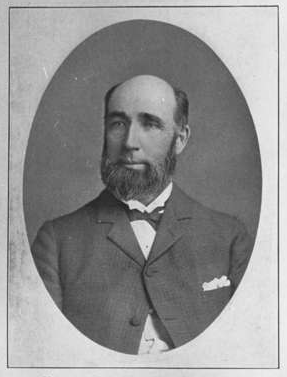
Senator George Albertus Cox
George Cox was born in Colborne, Ontario, just down the road from Cobourg and Port Hope. His parents were of English decent and had emigrated to Canada from the United States in 1818. He was orphaned at the age of five when his mother passed away giving birth. From that point he became a benefactor of the social safety net of the day and was adopted and educated in Colborne. Mr. Cox had a long memory for the folks that had helped him in life and persuaded the school board of Peterborough to hire his former teacher, Mr. Dickson, at a much increased wage.
After Cox finished school he became a telegraph operator for the Montreal Telegraph Company. The company would soon have telegraph poles along the length of the Port Hope and Lindsay Railway. After spending two years as an operator in Colborne, Cox moved to Peterborough in 1858 to head the company's office there. In addition to the telegraph business, he would also open a branch of the Canada Life Assurance Company, a company that he would become president of in 1899. During the 1860s he would become very much interested in photography, to the point of having a gallery and studio where citizens could obtain a photograph for as little as 50¢. I wonder if there are any early-Peterborough railway photographs of his hidden about the town.
Over the years Mr. Cox had become a prominent citizen of the town of Peterborough and was elected mayor just prior to, and after, his tenure as president of the Midland Railway. Throughout his life he had an unwavering interest in the well being of Peterborough and that of course would be of benefit to the town when he was appointed president of the Midland Railway. It was after his first term as mayor that he was appointed a trustee of the railway on behalf of the investors. Although the reconstruction process of the Midland company began when Hugel was president, with Cox as trustee and vice-president, it would be Cox who would see it through to a very prosperous end. It was said on more than a few occasions the he was the right man, at the right time, for the job.
After being appointed president, Cox pushed the road to completion and began to resolve the financial crisis which would require him to put up some of his own securities to obtain credit. Mr. Cox was eventually able to settle with most of the creditors in accordance to the Act passed in 1878. A revised edition of that Act allowed the company to issue bonds to the amount of £150,000 and use them, along with an additional £65,000 from a previous issue not yet disposed of, as security to obtain steel rails, ballasting, fencing etc. for the roadway, as well as a new locomotive and cars needed to increase revenue. After years of stagnation the recovering economy created additional revenue to assist in the rebuilding the road and renewing the long deprived interest payments to the investors. Private investment had built new grain elevators at Port Hope and Midland that the company had the option to purchase at any time. To increase and stabilize rates Mr. Cox was able to create accords with the competing railways in the region which benefitted all involved including the clients.
Under the wing of the Grand Trunk Railway, Mr. Cox would be the key figure in the amalgamation of all the failing roads in the region. The reduction in operating expenses and staff made by Mr. Cox would render all but the Victoria Railway profitable. By 1883 the Grand Trunk had declared to their shareholders that they had obtained all of the Midland Railway's available stock; the sale of which made Cox a millionaire.
George Cox would resign from the presidency of the Midland when the Grand Truck leased the road in January, 1884. He would again be elected as Mayor of Peterborough and go on to reach great heights in the world of Canadian Business. The list of companies he was involved with, from insurance and savings and loans to coal and steel, was quite remarkable. In 1884 he founded the Central Canada Savings and Loans Company and in 1885 became a director of the Canadian Bank of Commerce. He was also a supporter of the Methodist Church and would donate one of his properties in Peterborough rent free to a social assistance program for poor immigrant children.
In 1887 Cox and his wife would move to Toronto where, in 1890, he would become President Canadian Bank of Commerce. Cox would oversee the companies growth from thirty plus branches in Ontario to 166 across Canada, including one branch in London, England and six in the United States, by 1906.
Mr. Cox would be called to the senate by the Wilfred Laurier government in 1896.
Midland Bankrupt, George A. Cox appointed President
When in September of 1878 the men working on the extension to Midland struck for their arrears of wages, and once again came down to Port Hope and stopped the rail traffic, all means of acquiring addition moneys under the current management of Adolph Hugel were exhausted. In order to acquire the funds necessary to continue operations, George Cox, a trustee of the bondholders representing Peterborough's interest, and vice-president of the Midland Railway at the time, would have to put forth personnel securities to obtain further loans from "parties largely interested" and replace Mr. Hugel as president of the company. Mr. Cox took control of the road in October after being elected by the current stockholders. With Steel, not iron, rails already arriving on the scene, as well as three new iron bridges prior to the forthcoming spring freshet, it may not be too presumptuous to surmise, given the financial state of the company, that the Grand Trunk already had a stake, so to speak, in the Midland Railway at this point in time. When Hugel had reached Waubaushene, it was reported that there was not a single iron rail to be found on the entire road to be used for maintenance. Mr. Cox himself was later quoted as saying: "This road is in a desperate state of repair--rotten bridges, worn-out rails, and generally dilapidated". Rumours were also reported to be circulating in regards to a partnership between the Whitby, Port Perry and Lindsay. The road had reached Lindsay just over a year ago and had forced a reduction in rates preceding its arrival.
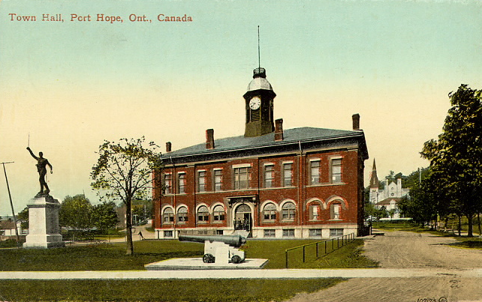
Town Hall Port Hope - Midland locomotive named after man in statue form, A.T.H. Williams
The rail extension had just reached Victoria Harbour, the original projected terminus of the railway. Adolph Hugel had missed his objective by only a few miles, but to think the railway could have prospered under it's current debt load would be unrealistic to say the least. The government sanctioned reorganization would be necessary to clear the majority of the debt load. The Midland Railway was indebted to numerous creditors, including the Portland Company for locomotives and the Georgian Bay Lumber Company for ties etc., just to name a few. Three hundred creditors, representing roughly $560,000 in floating debt, attended a meeting at the Town Hall in Port Hope to address the concern in March of 1879. Mr. Cox had recently been re-elected president of the road, now fully under the control of the bondholders. He stated that in order to avoid a foreclosure by the bondholders, which would result in the sale of the roads assets going to them, creditors without security should settle for a small percentage of what was owed to them. Mr. Cox had estimated the value of the company to be 1.5 million and the first mortgage was greater than that, leaving nothing for the other creditors. In the hierarchy of creditors of a railroad, those possessing first mortgage bonds would have the first lien on the company's holdings, followed by second mortgage bondholders, who would often be given stock, or in this case a percentage in new bonds, followed by the stockholders who could receive new stock at a loss, or in the case of foreclosure lose their investment entirely. In the case of the Midland, the floating or short term debts would be paid for with a new issue of government sanctioned company bonds, or alternatively with 22.5 cents cash on the dollar owed. As was often the case, the bondholders were gifted by the government with a fresh start free of debt, whereas the stockholders, followed by the unsecured creditors, had to settle for a substantial loss at best.
At the end of March 1879, with the reorganization of the company nearing completion and new directors being elected, construction of the road was continued on toward Midland.
By June, Mr. Cox had trimmed the staff of the railway and engineered, together with Messrs. Holden and Austin of the Whitby, Port Perry, and Lindsay Railway, a pooling of gross earnings between the two roads. No sooner had the Whitby road reached Lindsay than they consolidated with the Midland and the monopoly was restored. The citizens of Lindsay were obviously not too pleased given the substantial investment they had made in the Whitby and Port Perry road. However, this arrangement was no doubt a wise move on the part of the Whitby and Port Perry management, given the damage a rate war with the Midland, possibly backed by the Grand Trunk, would cause. The gross earnings of the two roads were split at 79% to the Midland and 21% to the W.P.P.& L. The agreement was for a period of twenty years with an option to dissolve after three. The claimed benefit to the public was that the freight would take the shortest route over one or both roads. The Grand Trunk apparently had no issue with the agreement even though shipping via the shorter path would, in some cases, be at their expense(e.g. transhipped on G.T.R. to Montreal via Port Hope instead of Whitby). Mr. Cox was appointed chairman of the joint board overseeing the agreement.
It should also be noted that during the summer of 1879 the economy was beginning to recover from the long depression which had befallen Mr. Hugel and company in 1873.
Midland Bay at Last!
In June of 1879, the railway had finally reached it's terminus at Midland City, and on July 15th, after government inspection, was officially opened for business. The following article correctly forecasts details regarding the future freight and passenger traffic along the Midland and Port Hope, later Belleville, mainline of the Midland Railway of Canada.
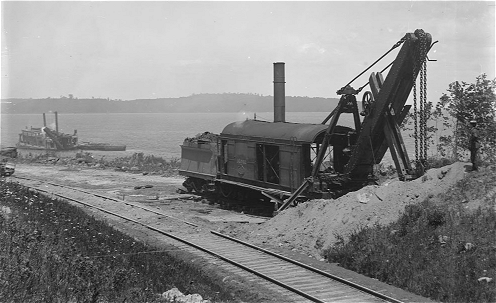
Original cut leading to Midland Bay being escavated ca. 1897 - Andrew Merrilees / Library and Archives Canada
We are glad to observe what appears to be the dawn of an era of prosperity for the Midland Railway. The line is now complete from Port Hope to Midland, thanks to the indomitable energy of the President, Mr. Cox, and the contractors for the extension, Messrs. Dickson and Gibson, of Port Union. A pooling arrangement with the Whitby, Lindsay & Port Perry line puts an end to a possibly disastrous competition, and a newly arranged plan of close through connection with the Grand Trunk, gives promise of increased passenger traffic. The company is relieved from any immediate financial embarrassment and is in such a position as to be able to effect certain improvements, that will facilitate traffic and conduce to an increase of freights.
The completion of the line to Midland is an event, the importance which can hardly be overestimated. Midland Bay offers not only one of the best on the lake, but perhaps the very best. It is said, in fact, to rank among the great harbours of the world. It is capacious, yet perfectly land-locked; safe, yet easy of access; deep enough for the largest vessels, and yet contains the best of anchorage. Its importance is still further enhanced by the fact that nearly all of the harbours of the Georgian Bay are unsatisfactory, and mariners show an inclination to avoid them. Easy communication is thus opened up with an extensive lumbering district, beyond that previously within the scope of the Railway. The mills at Midland alone have a capacity of nearly 30,000,000 feet, Mr. W. H. Cook's mill alone producing at least 18,000,000 feet in the season. The are large numbers of mills about this portion of Georgian Bay and within a short sail of Midland , such as those of the following places: Parry Sound, Byng Inlet, Penetanguishene, Sturgeon Bay, Wye River, Hog Bay, etc., all of which combined produce annually well on to 150,000,000 feet. A large portion of this must eventually find its way over the Midland as the most direct route to many parts of Ontario and the United States, and much of this will be in addition to what has been heretofore transported over this line.
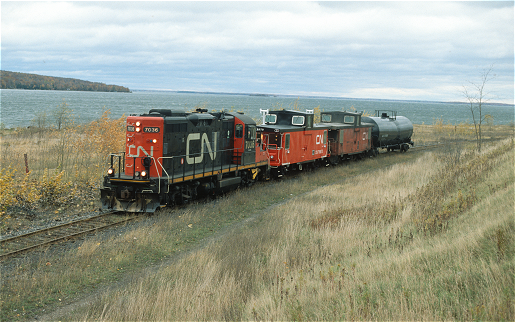
Same location on Midland Bay, Oct. 1993 - Photo by Author
This will give the reader a general idea of the vast extent of the lumber trade that is in store for the road, more especially, when the business at some future day is relieved from the somewhat depressed state in which it now is; and this is leaving out of account the trade in square lumber, which may yet also assume very considerable proportions by this route. There is, however, another very important consideration in connection with this route to which we desire more particularly to draw attention, and that is the facilities it offers to the through grain trade. A writer in the Montreal Gazzette, a short time since, showed most conclusively that grain could be carried from Chicago to Midland by water, transhipped there and taken thence by rail via Midland and G.T.R. to Montreal fully as cheaply and with much greater dispatch than by the all water route. Now, this being the case, what is to prevent the same thing being done in the future transport of grain from Manitoba and the Northwest? The completion of the Pacific Railway between Thunder Bay and Selkirk on the Red River will bring Manitoba within 400 miles of Lake Superior by rail, and it is by that route, as soon as completed, that the principal part of the surplus grain of the Canadain Northwest will find its way out. Wheat can be carried on that route from Selkirk to Fort WIlliam for six cents per bushel at the outside and four cents more will carry it to Midland and pay for its transhipment. Thence to Montreal by Midland and G.T.R. will probably cost another six cents, so that at the outside rates the cost of transporting a bushel of from Manitoba to tidewater will not be more than sixteen cents. This is, doubtless, the cheapest route that will be available for many years, and it is the shortest. It is considerably shorter than any of the existing mixed rail and water routes and is more than 500 miles shorter than the all-rail route. If this route were once well established, with a good line of steamers, it would soon become a popular one for passenger travel during the summer months; and the return freightage would gradually increase to such an extent as to materially lessen the cost of providing for down freight.

Midland and Penetanguishene Bays on Georgian Bay
Another very considerable source of revenue to the Midland is that to be derived from the pleasure-seeking community. There is, perhaps, no line in Canada that, in proportion to its length, offers so many attractions to tourists; and when the present depression throughout Canada and the States shall have passed away and the numbers of this class shall have increased again to their former dimensions and beyond, this line ought to come in for a considerable share of their patronage. But independently of those from a distance who come to enjoy the advantages and attractions of the tour, the people living along the line itself would do well to avail themselves of these opportunities for enjoyment that lie almost at their doors, and which many less favourable situated are compelled to seek at a considerable outlay of time and money.
We might say, before closing, that the position the road occupies to-day and the prospects that lie before it are in no small degree due to the energy and efficiency of its officers, both present and past. Mr. Hugel fought earnestly to overcome difficulties that seemed insurmountable, and everybody agrees, and the facts all go to show, that Mr. Cox, since his acceptance of the position of President, has been the right man in the right place. He has able and indefatigable assistants in Mr. Taylor, as Superintendent, and Mr. White, as General Traffic Agent, and we trust that the near future will show that the efforts of all who have had connection with the road in its darker days have not been in vain.
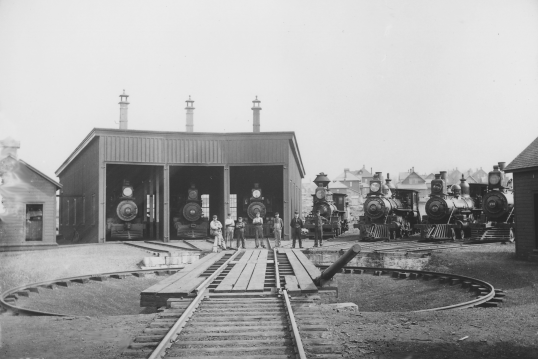
Midland Turntable - Huronia Museum
By the fall of 1879 steel rails had replaced the old iron rails between the harbour at Port Hope and Millbrook where the branch line to Peterborough connects. At this time there was the first signs of concern in Port Hope over Belleville's Grand Junction Railway, currently at Hasting and building to Peterborough, now being leased to the Grand Trunk Railway. The concern was that if the G.T.R. were to eventually gain control over the Grand Junction, that the projected through-grain traffic, and existing Peterborough lumber traffic, would by-pass Port Hope and take the easier-to-navigate routes up the St. Lawrence by barge, or across the lake to Oswego, via Belleville. The Grand Junction was to issue bonds guaranteed by the Grand Trunk for the completion of the road to Peterborough, essentially gaining a foothold in the company. The powers at be in Port Hope had good reason to be concerned, as not only was their own road slipping into the hands of the Grand Trunk, but so was another that had a more convenient port for export than their own.
Interestingly enough, the Midland had also applied for powers to construct an extension that would have proceeded along a similar path as the Canadian Pacific's present day Mactier and Parry Sound subdivisions. The extension would branch off from Coldwater and cross the Severn river near it's mouth were the mills were situated, and then on to Bala, Parry Sound, and as far north as the west end of lake Nipissing.
Increased Prosperity
To begin 1880, Mr. Cox had, in addition to the aforementioned arrangement with the Whitby, Port Perry and Lindsay, an new agreement with the North and North Western Railway(formerly the Northern Railway, that crossed paths with the Midland at Orillia), for equal rates between competing points. There was also an an accord with the Victoria Railway, the forever non-profitable line north of Lindsay, for rates and assistance in developing their mineral and forest products. These arrangements with competing roads created a virtual monopoly for the railways of the Midland district, resulting in the desired increased rates for all. A plan to amalgamate the Midland district lines was no doubt in the works at this time and it was in the interest of Mr. Cox and friends to create a profitable environment for all roads concerned in the scheme. In order to allow for the sales of bonds needed to pay for the new steel and further improve the road, the act assented to in 1878 had to be altered to repeal a section regarding the unsecured creditors. To the irritation of the few holdout creditors, the bill passed along with the power to extend the line north to the French River and Lake Nipissing. Construction on a new elevator at Midland City, to accommodate the through-grain trade, would begin and the first year of lumber traffic from the town would increase revenue. Soon the bondholders would receive their first dividend in many years.
At the end of the year, another indication of the future diversion of traffic away from Port Hope would come when the bond and share holders in London refused the idea, floated by Mr. Cox, of purchasing the harbour in that town. The consensus being that with the future amalgamation of the Midland region lines a being real possibility, there would naturally be created a healthy competition between the ports at Toronto, Whitby, Port Hope and Belleville for the rail business. That, however, may have been the amicable way to say they preferred Belleville for much of the eastbound traffic.
When in 1880 it was alleged that the Grand Trunk was placing feeder lines in a position of servitude, the general manager of said railway, the Mr. Joseph Hickson, wrote to the managers of the Midland region lines asking to be informed in what respect the Grand Trunk was placing it in a position of servitude, and what emancipation was desired.
Mr. Cox opened his reply with: "Our arrangements with the Grand Trunk are in every respect satisfactory. There is no servitude from which we desire to be emancipated. On the contrary, we have an equitable division of through rates to and from all points on your line, and every advantage and facility for both our passengers and freight business." And the other roads responded in kind.

Original Midland City Grain Elevator - Topley Studio / Library and Archives Canada / PA-008550
At the start of the year 1881, the Midland Railway bonds had increased to 91 cents on the dollar and were expected to be at par by May. Within a short period of time the creditors who opted for the bonds in lieu of the 22.5 cents on the dollar payment had made a substantial profit on their somewhat forced investment, and would receive interest payments in addition. However, it seems that most, perhaps out of desperation, opted for the payment. Also in January was the completion of the new, and very commodious, grain elevator in Midland City. The cost to complete the elevator was $30,000, with the 45hp elevating engine produced at the Hamilton works in Peterborough, the massive stonework on the foundation by Mr. Trick of Port Hope, and the eavestrough and other tinwork by Mr. Dun of Midland City.
Lumber industry products emanating from the different reaches of the Midland Railway showed increased growth over the previously years. By far the most shipped, approximately one quarter of the total business, came from the mills at Waubaushene and Port Severn. This was followed by the combined total from Peterborough and Nassau Mills, followed by Bobcaygeon via Lakefield, and then Midland City and Fenelon Falls with an equal amount shipped. The Georgian Bay area produced approximately one half of the total lumber and timber shipped. A huge increase was projected for 1881 with the establishment, by lumberman Hermann H. Cook of Midland City, of the British Canadian Lumber and Timber Company that had constructed a mill in Scotland and three in Canada - one located on "Hugel Point" in Midland City. Unfortunately, this company would eventually fail and the lumber trade in general would begin to decline again in 1884. At that point in time the only lumber within close proximity to the railway was on what was soon to become the Victoria branch of the Midland. However, large tracts of land secured by the milling companies on the eastern and northern shores of Georgian Bay would continue to supply white and red pine for the mills for many years to come.
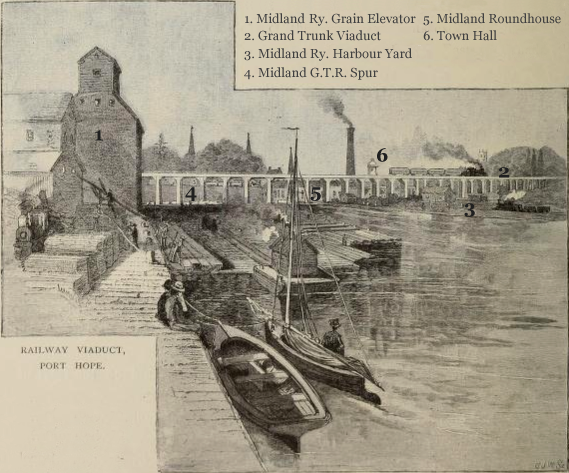
Port Hope, 1881 - Picturesque Canada
If the harbour rejection wasn't enough to raise red flags in Port Hope, the latest petition by the company to the Legislature regarding amendments to current legislation no doubt would have. The new Act assented to in March gave the company the power to build a link between Omemee and Peterborough. One of the obvious benefits for the railway being a more direct route to Peterborough, and, of more concern, the port of Belleville, from Georgian Bay. Further powers in the Act stated that it shall be lawful for the company to:
a)lease the railway to any other railway company, or to lease the railway of any other railway company; b)purchase the line of any other company, duly authorized to sell the same; c)sell the railway together with all and singular, the franchises, houses, buildings, stations, station grounds, rights, ways, privileges and appurtenances of the company, to any other railway company, duly authorized in that behalf; d)sell preferential stock to the amount of £100,000, and the holders of the preferrential stock hereby created, or so much thereof as may from time to time be created, shall have all the rights and powers as to voting which belong to shareholders in the capital stock of the company
A summer meeting of the town council of Peterborough regarding a $40,000 bonus (in the form of debt reduction; the company owing the town $65,000) to help the railway build the "Missing Link" connection between Omemee and Peterborough raised more concerns for Port Hope. Mr. Cox had stated that the new main line of the railway would be between Midland and Belleville--with the line to Port Hope becoming a branch! Furthermore, the meetings main focus seemed to be the removal of the shops from Port Hope to Peterborough after the new mainline had been completed. Meanwhile, in Port Hope, in an unprecedented move, the current harbour commissioner, Mr. Lewis Ross, a director of the Midland Railway and former M.P. for Durham East, was re-elected after already serving a two-year term. It was the custom up until that point in time to replace the harbour commissioner after serving one term.
Peterborough was able dodge the $75,000 bonus granted to the failed Grand Junction Railway and the $150,000 bonus granted to the Toronto and Ottawa when the construction deadline expired.
Consolidation of Midland Region Railways
Just when the financial and operational side of the business had been put in order, a new rail line surveyed through the Midland district, the Ontario and Quebec Railway, would soon be granted a charter as part of the government-backed Canadian Pacific's network in Ontario . The line would run east from Toronto through Peterborough on route to Perth and a connection with the Canadian Pacific. Mr. Cox had been part of a syndicate of Ontario businessmen formed to present an alternate bid for the construction of the Canadian Pacific Railway. Though less than the alternative, the conservative government of the day rejected the bid.
As previously mentioned, a somewhat secretive alliance between the Midland and the Grand Trunk had become apparent. With the Toronto and Nipissing bankrupt and holding the Toronto and Ottawa charter, and the Grand Junction slowly building toward Peterborough, being the odd road out of a proposed amalgamation, and thus surrounded by Grand Trunk and Canadian Pacific controlled lines, could potentially be ruinous for the Midland. Being under the wing of the Grand Trunk was the practical thing for President Cox and company to do on behalf of all invested. When questioned about Grand Trunk involvement in the Midland Railway, Mr. Cox simply stated that they are doing their business and we are doing ours. Mr. Halsey, trustee and director for the London ring of the Midland, had stated at a shareholders meeting that the defining reason for the Midland joining the alliance was the threat from the other roads, presumably under the control of the Grand Trunk, building into and through Peterborough from the east and connecting with Toronto. The bankrupt Toronto and Nipissing was in no position to build the recently acquired Toronto and Ottawa charter let alone make a connection with it; therefore the presumption that "people stronger than ourselves" was in reference to the Grand Trunk. Mr. Gooderham of the Toronto and Nipissing had been accused by some of doing the bidding of the Grand Trunk in proceeding with surveys on the Toronto and Ottawa which paralleled the Ontario and Quebec charter. Nevertheless, the Ontario and Quebec charter was granted and construction began shortly thereafter.
Conversely, the Grand Truck was talking to their shareholders of an expected large increase in traffic from Chicago, which they had recently gained access to, and the Northwest. In what was perhaps a primer for future dealings, it was suggested to the shareholders that the Toronto and Ottawa charter could be made profitable under the Grand Trunk, but not likely a threat otherwise.
At the end of the eventful year of 1881, a general meeting of the Midland Railway was held to outline a proposal the directors had been working on to consolidate the different railway lines in the Midland region. Although there were active agreements with all the roads concerned, regarding rates etc., President Cox had stated that the companies are "located as to more or less interfere injurously the one with the other whilst under separate management". It was also said at the time that the scheme was developed under the auspices of the Grand Trunk. The companies considering consolidation were:
- The Midland Railway of Canada (projected $400,000 per annum)
- The Toronto and Nipissing Railway ($200,000 per annum)
- The Grand Junction Railway (projected $115,000 per annum)
- The Whitby, Port Perry and Lindsay Railway (projected $105,000 per annum)
- The Victoria Railway ($45,000 per annum)
- The Toronto and Ottawa
The Toronto and Ottawa charter would a)provide a link between Omemee and Peterborough to shorten the proposed new main line between Midland and Belleville; b)create a link between Manilla, on the Whitby line, and Wick(Blackwater Junction), on the Nipissing line, to considerably shorten the distance from Lindsay and Peterborough to Toronto; c) facilitate an extension from Madoc on the Grand Junction division to Ottawa, thus creating a link between Toronto and Ottawa on the Midland network, and d) not fall into the hands of the Canadian Pacific who were trying to piece together a network across Ontario. As mentioned, the Toronto and Ottawa was owned by Toronto businessman William Gooderham Jr., who was also the president of Toronto and Nipissing Railway. Our old friend John Fowler had been involved with this line prior to the purchase by Mr. Gooderham.
Belleville's Grand Junction Railway would face insurmountable opposition from both the Grand Trunk and Midland prior to and upon entry into the town of Peterborough. Upon finally completing construction between Belleville and Peterborough the road was involved in an unsuccessful rate war and battle (over running rights on the old right-of-ways of the Cobourg and Peterborough, and Peterborough and Chemong, railways on the east side of the Otonabee River in Ashburnham) with President Cox and the Midland Railway. The Grand Junction was subsequently purchased by The Grand Trunk Railway just as it's rolling stock was being seized by creditors, and then leased to the Midland. The citizens of Belleville had contributed $150,000 towards the construction of the line just to have it gobbled up by the Grand Trunk mere months after reaching Peterborough.
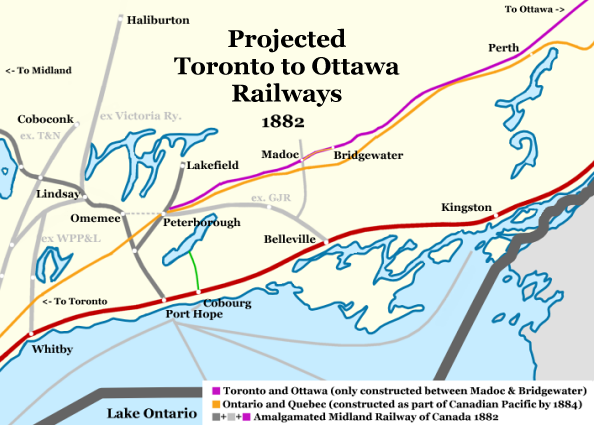
Projected Routes of the Toronto-Ottawa Railways 1882
In January, 1882, the Secretary of the Canadian Pacific, Mr. Drinkwater, claimed that the company had "no connection with and no intention of being interested in any railway project east or south of Montreal, or west of Perth." In March the Ontario and Quebec Railway was chartered and in September notice was given that construction would commence. Construction on the line was completed in 1884.
In May, 1882, Mr. Cox had stated that "The Toronto and Ottawa line now under construction from Madoc eastward, passes through a rich mining and agricultural district, a distance of 113 miles to the city of Ottawa, thus giving the consolidated system a direct and independent line to the capital of the Dominion, where connection is made with the Canada Pacific, Quebec, Montreal and Occidental; and Canada Atlantic Railways, thereby providing a second direct through line from the west to the east." Contrary to the Canadian Pacific about-face, the Toronto and Ottawa road was only fully constructed a short distance between Madoc and Bridgewater. Even with the backing of the Grand Trunk, it is doubtful that the line would prove profitable for the Midland with the parallel Ontario and Quebec/C.P.R. line guaranteed to be built, and the Grand Trunk must have thought as much as they decided not to complete the construction after gaining full control of the Midland.
The consolidation scheme, agreed to by all concerned roads in December of 1881, was put to the provincial legislature and enacted into law on March 10, 1882. As you may well imagine the Act was quite long winded with all of the separate companies specifics needing to be dealt with. The shares of all were to be exchanged dollar for dollar and a new bond issue to replace the outstanding bonds of the individual roads. Until the outstanding bonds for the individual lines had been taken in, any default in interest payments by the roads would be exacted from the profits of the others. The Grand Trunk had also guaranteed the interest, in the form of a transhipping rebate, for the Nipissing and Grand Junction sections. The total of the Grand Junction bonds, £226,000, was equal to the total of all other roads, minus the Midland, and if purchased could reimburse the Grand Trunk for their outlay. The act further empowered the new company to install a new committee in London that just happened to be chaired by Sir Henry Tyler, president of the Grand Trunk, and committee member Sir Charles Young, vice-president of the Grand Trunk. At this time Sir Henry was skillfully engineering a takeover of the Great Western Railway of Canada in another amalgamation that would take effect in the summer. Decisions/voting on such concerns were often made in advance and by agents representing the (sometimes ill-informed) investors - opening the door for all sorts of goings-on. The Grand Trunk had successfully eliminated all of the Midland district roads and the Great Western of southwestern Ontario from various forms of incorporation into the government-backed Canadian Pacific network in the province.
Predictably, in the aftermath of the amalgamations, articles composed of anti-monopoly sentiments were soon to be found in the local newspapers:
Parliament should appoint a Railway Board or Commission to fix rates for goods and passengers, and thus stamp out monopoly. What with the Grand Trunk and it's feeders spread out like a great Octopus whose tentacles are ever ready to gobble up everything that comes in the way of its capacious maw. It is full time for the electorate at large to put on their thinking caps and try to comprehend what will be the outcome of this gigantic amalgamation of railroads that is quietly going on, and see to it that our members of Parliament should with both vote and voice, take the side of the people over the monopolies.
and
Since the railway amalgamation some time ago Fenelon Falls has been a place of but little importance in the eyes of the monopolists, and we have frequently had to complain of the annoying irregularity of the mails. On Wednesday of this week there was a heavy fall of snow, commencing about 10 a.m. and lasting until after dark, in consequence of which the train from the south only got as far as Cameron and then returned to Lindsay and did not reach the Falls until six o'clock next evening. Of course no one expects the trains to do impossibilities; but we have heard it stated that the engine employed on the Victoria branch of the Midland Railways is so weak and defective that a very moderate snowdrift is enough to arrest its progress, and that it frequently balks for an hour or so without any exciting cause, and has to be coaxed and petted before it will go on again.
are two such examples.
Completing the Line
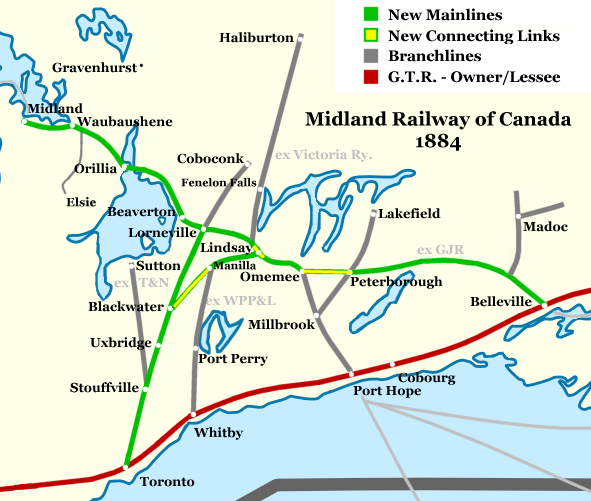
Midland Division of the Grand Trunk Railway
During 1883 work progressed on and was completed on many of the post-amalgamation projects necessary to solidify the new rail network. The Nipissing section was fully converted from narrow gauge to standard gauge rails and thus created a through connection from all points on the line and Toronto. The new bypass between Lindsay and Wick(Blackwater) Junction lessened the mileage for trains heading west to Toronto by ten miles, but forced angry travelers on the Coboconk line to travel further, and at an increase cost, to reach Lindsay and points beyond. The old line running between Lorneville and Lindsay would continue as the main line for freight emanating from the northwest, but only provide a passenger service on a mixed(freight/passenger) train, which, as one could well imagine, was not overly enticing especially if you were in a hurry.
The "Missing Link" bypass of Millbrook and the branch to Peterborough was still under construction in 1883 but would be completed near the end of the year. The terrain along the route proved to be somewhat difficult to run a rail line through; however, as is often the case, was very scenic as a result. Construction was also completed on a bypass of the old East Ward section of the town of Lindsay. The swing bridge that crossed the Scugog River, built during the expansion to Beaverton, was not at an ideal location for the through-grain traffic to pass over given all the steamship movement below the lock. Major repairs, or an all-out replacement, would have been necessary at that point or in the very near future. A new bridge was built above the lock (to the south) that allowed for steamers to pass underneath, and a new, albeit small, station was built on Durham St. just down the road from the old Union Station of the former Whitby and Victoria roads. (This new station burnt to the ground in Jan. 8th, 1885, and the railway had to revert back to the Union station for four few more years.) These upgrades to the line, combined, cost about half a million dollars! The former Victoria Railway ran north up the middle of Victoria Ave. to Victoria Crossing/Junction where it intersected and connected with the Midland Railway prior to the amalgamation. Now, and for the forseeeable future, all of the through-freight traffic on the Midland section would travel up and down the center of this street - irritating the folks travelling the Victoria section, or indulging in the amenities of the mixed from Lorneville, even more.
By mid-1883 the Grand Trunk had announced that they had gained control of all of the amalgamated Midland Railways available stock which amounted to $4,316,920 of a total $6,600,000; with the balance being held in reserve. Mr. Cox had concluded his outstanding, and very fortuitous in comparison with Mr. Hugel, tenure as president with the sale of the road for a substantial profit for the investors and himself. Ex-presidents Henry Covert and Adolph Hugel were at stockholder meetings prior to the amalgamation, and profits made by Mr. Cox made him a millionaire at a time when a million dollars was a large sum of money indeed. He would go on to become one of the richest business men in Toronto, and the whole of Canada, with a net worth of over $5,000,000. This resurgence of the railway did, however, come at a cost to the Grand Trunk, with the new consolidated bond debt escalating to £1,122,400 and interest to be paid.
Back to work on the model ca. 1883
And that is the abbreviated history of the Midland Railway up to the point were it appears in the model. At the time, a fully functional well constructed line with steel rails on a fully ballasted roadbed, enhanced with newly adopted locomotives and new cars to transport passengers and a abundance of freight. The same company that built the Midland grain elevator had also built one in Port Hope, and the lumber and timber was pouring in from the Georgian Bay mills, the Strickland operations, and many others - not to mention all of the other exportable goods. Once the missing link was completed between Omemee and Peterborough in 1884, a new, more cost effective, mainline and outlet at Belleville would be adopted.
Future Midland Railway line developments
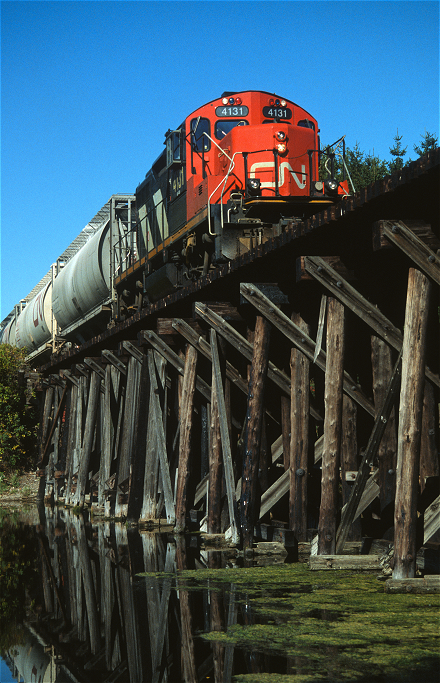
Wye Trestle Oct, 1994 - Photo by Author
The Midland Railway of Canada would be officially leased by the Grand Trunk beginning January 1st, 1884. At this time the old numbers on the locomotives would be retired and allotted the Grand Trunk 601-623 range of numbers, and presumably also lost their names. Ten years later the Midland would lose it's identity altogether when an amalgamation of Grand Trunk short lines occurred in 1893. The Grand Trunk itself, becoming bankrupt after the First World War, would eventually be absorbed into the Canadian National Railways in 1923. The lumber trade along the road continued until around 1925, and the bulk of the through-grain traffic would continue until the St. Lawrence Seaway was completed in 1959. Much of the grain that fed the United Kingdom and the Soviet Union during World War II was shipped across this line.
Today the original line between Port Hope and Midland is completely abandoned as a railway. There is however a stretch of the Nipissing section between Uxbridge and Stoufville that is currently being operated as tourist railway. Otherwise, the majority of the old line is now preserved as part of the rail-trail network in the province. The portion between Waubaushene and the Wye River is an excellent paved trail along the original course of the roadbed. Beyond that the route strays a little from its original path as it makes it way through the new development at Tiffin and then along the Midland bayshore, once lined with saw and shingle mills and later a massive shipyard and coal dock. Severn Township has recently purchased the right-of-way between Waubaushene and Coldwater and has made a decent trail with a crushed stone surface. You can park in Coldwater and walk/ride a few hundred meters down the old Medonte Tramway to begin the journey to Waubaushene. East of Coldwater the trail transfers to the old Canadian Pacific right-of-way all the way to Orillia. Although no trail exist east of Orillia, there is a surviving piece of the right-of-way now in use by the Canadian National just north of Beaverton and to the south of the Talbot river. Going north the track crosses from the old Canadaian Northern right-of-way to the old Midland right-of-way for a scenic 500 meters or so along lake Simcoe before crossing the Trent-Severn canal and returning to the old Canadian Northern roadbed at Gamebridge. The section on the Midland leading up to the Talbot river and beyond the Trent-Severn was, however, elevated in 1911 when the Canadian Northern and the Trent Canal were built - making that section non-original as far as elevation is concerned. Beyond Beaverton, heading further east and not quite all the way to Lindsay, is now occupied by a powerline right-of-way, and thus very easy to follow through the farmlands. Inside the town of Lindsay you can walk the original line along the Scugog River from the lock down to the bridge that was built as part of the East Ward bypass in 1883. From east of Lindsay you can pick up the rail trail through to Omemee, and then onto the "Missing Link" section into Peterborough. The scenic Lakefield Rail Trail starts at Trent University north of Peterborough and heads north along the Otanabee river to Lakefield. You can even travel a short section of the Cobourg/Chemong and Peterborough from Rotary Park down through the old station grounds in Ashburnham. Portions of the lines that merged with the Midland have sections of the roadbed converted to trails as well. Most of the Grand Junction is now a trail, and the Uxbridge Rail Trail on the Nipissing line runs north from the town across a restored wooden trestle bridge originally built in 1872. I also remember travelling up the Haliburton Rail Trail between Kinmount and Haliburton many years ago.
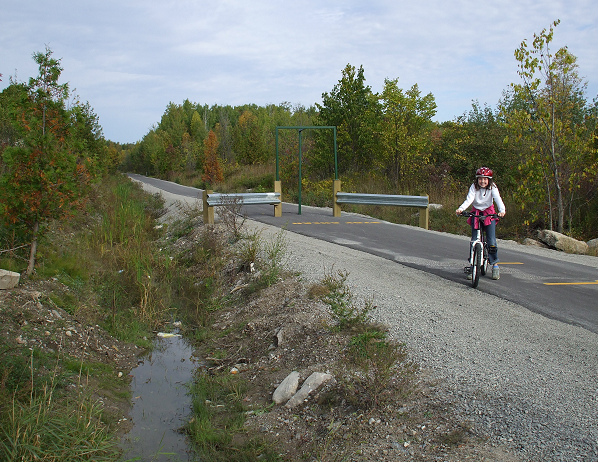
Victoria Harbour 2010 - Photo by Author
I imagine that the line was referred to as the "Midland" for quite some time after the Grand Trunk and Canadian National took control of the road. I found it interesting to read in a publication dating to the early-1990s a picture with the caption: "Midland Railway engine #5600" ca. 1945".
My own connection with the line came about just prior to closing of operations to the town of Midland in 1994. At the time, between 1992-1995, I was photographing many of the rail lines in Ontario and, residing a few blocks from the old right-of-way, was able to acquire dozens of pics of the last trains along the Midland Division of the Canadian National. One or two may have sufficed, however, as just prior to the abandonment the Midland turn often had the same engine, one or two cars, and a caboose. The rail structure was well worn and a speed limit was imposed beyond the quarry at Uthoff, northwest of Orillia. I have a few nails that I dislodged from the ties at Tiffin that dated them to the 1930s and 40s. Much of the ballast there was Sudbury slag. I believe the line from Orillia to the quarry was 115lb ribbon rail, as was the section on the old Northern(CN Newmarket) between Orillia and Barrie where the locomotives were stationed.
Modern Day Pics along the ex. Midland and Northern lines in Huronia
Reference Materials
Books
For further reading on the railways and personel associated with the Midland Railway of Canada, the following books will be of great interest. Most can be found on eBay and other used book dealers online, or through your local library in Ontario, Canada.
- Narrow Gauge For Us: The Story of the Toronto and Nipissing by Charles Cooper
- Narrow Gauge Through the Bush: Ontario's Toronto Grey & Bruce and Toronto & Nipissing Railways by Rod Clarke
- Four Whistles to Wood Up! Stories of the Northern Railway of Canada by Frank N. Walker
- The Grand Junction Railway by Nick and Helma Mika
- Haliburton by Rail and the I.B.&O. by Taylor Wilkins
- Constructed in Kingston by McQueen and Thomson
- Last Trains From Lindsay by Keith Hansen
- Canadian National Railways Vol. 1 - Sixty Years of Trial and Error by G.R. Stevens
- History Of the County Of Ontario 1615-1875 by Leo A. Johnson
- Midland on Georgian Bay: An Illustrated History of Midland, Ontario by Bill Northcott
- Steam Memories of Lindsay by Ian Wilson
- The Railways of Canada by J.M. & Edw. Trout
Available Online
- Charles Cooper's Railway Pages
- The Cobourg - Peterborough Railway
- Cobourg Peterborough Railway
- The Nip 'n Tuck - A History of the Whitby, Port Perry and Lindsay Railway.
- Victoria County Centennial History
- History of the County of Peterborough, Ontario
Other Related Books
- Gentlemen Engineers: The Careers of Frank and Walter Shanly by Richard White
- A Work Unfinished: The Making of the Trent Severn Waterway by James T. Angus
- Mills and Villagers of Severn Township by James T. Angus
- Railway Steamships of Ontario by Dana Ashdown
Copyright © Stephen M. Farrell 2019 All Rights Reserved
Some of the text, images and videos on this website are not public domain, please contact me for permission to use material on this website.